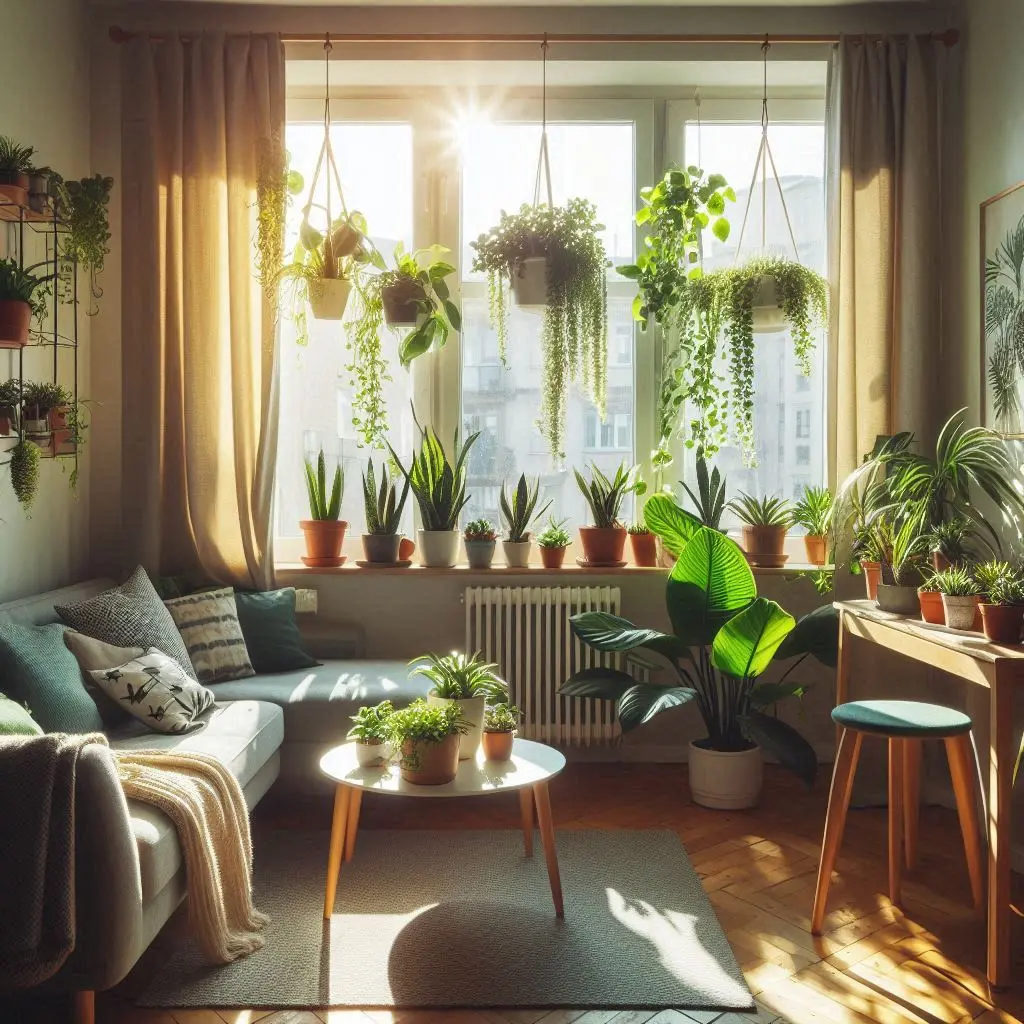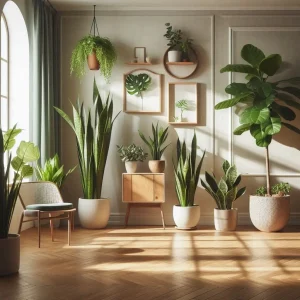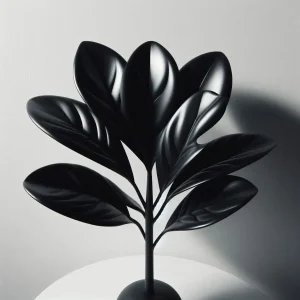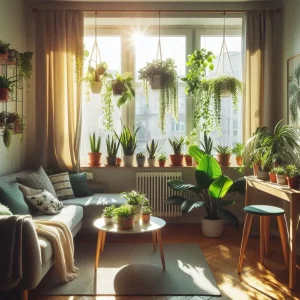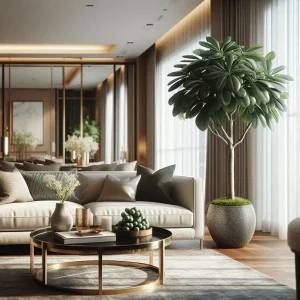“Japanese Ginseng Ficus Microcarpa Bonsai”
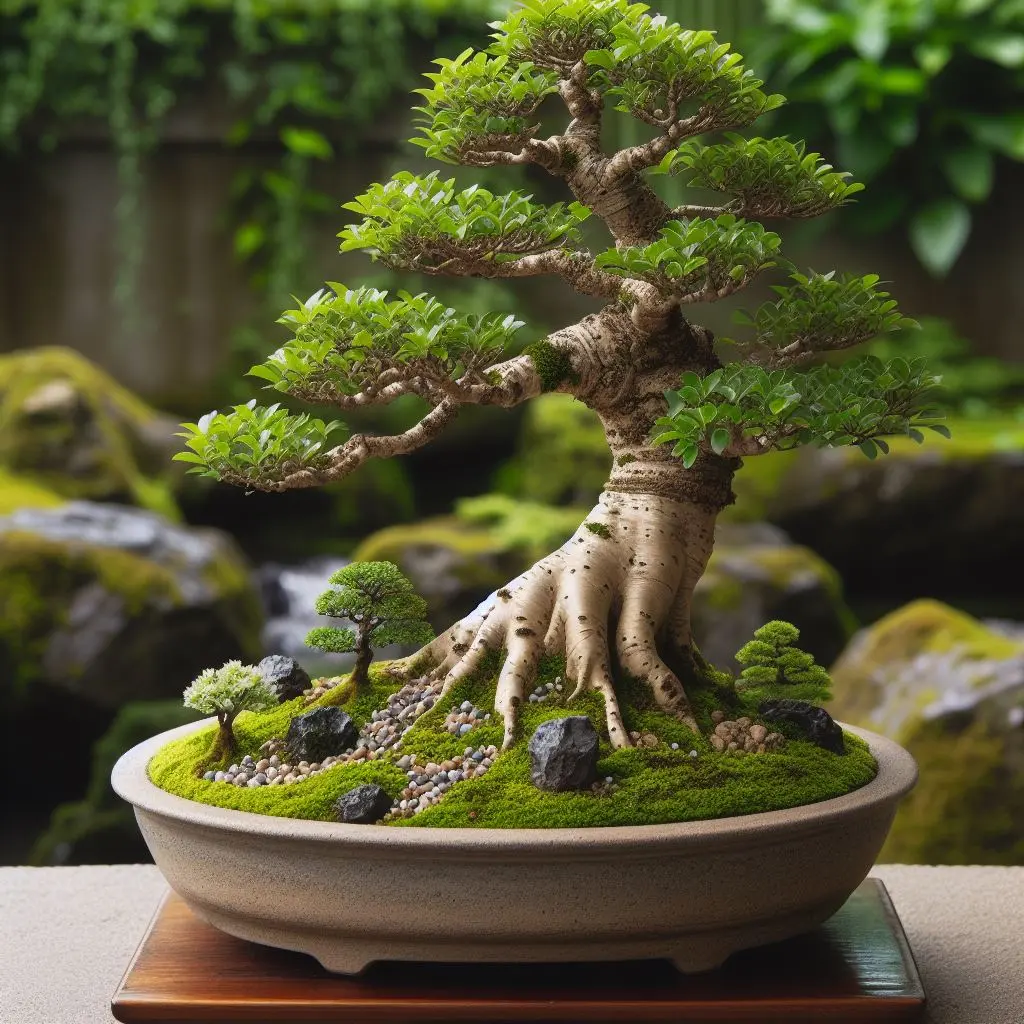
Transform your apartment into a northern forest with Japanese Ginseng Ficus Microcarpa Bonsai trees. Bonsai is a low-light indoor plant, and these tree blossoms are among the most beautiful and resilient apartment plants, enhancing any environment with their captivating presence.
The leaves of the bonsai are green, with a sharp and oval-shaped appearance. To envision the true face of various tree flowers, think of an ancient, gracefully aged tree in miniature dimensions – this is the authentic representation of a bonsai.
- Maintenance: Easy and adaptable
- Watering: Moderate + water before the soil dries out
- Light: Mild + indirect
- Soil: Suitable drainage + lightweight soil
- Plant Height: With standard care, the plant exhibits very good growth.
One of the crucial aspects to consider in caring for the Japanese Ginseng Ficus Bonsai is avoiding frequent relocation, as it may lead to leaf shedding.
| Feature | Specifications |
| Maintenance | Easy and compatible |
| Watering | Moderate + Water before the soil dries out |
| Light | Mild + Indirect sunlight |
| Soil | Proper drainage + Lightweight soil |
| Plant Height | With standard care, the plant exhibits excellent growth |
| Repositioning | Minimize moving to prevent leaf shedding as much as possible |
Pachira Aquatica (Money Tree)
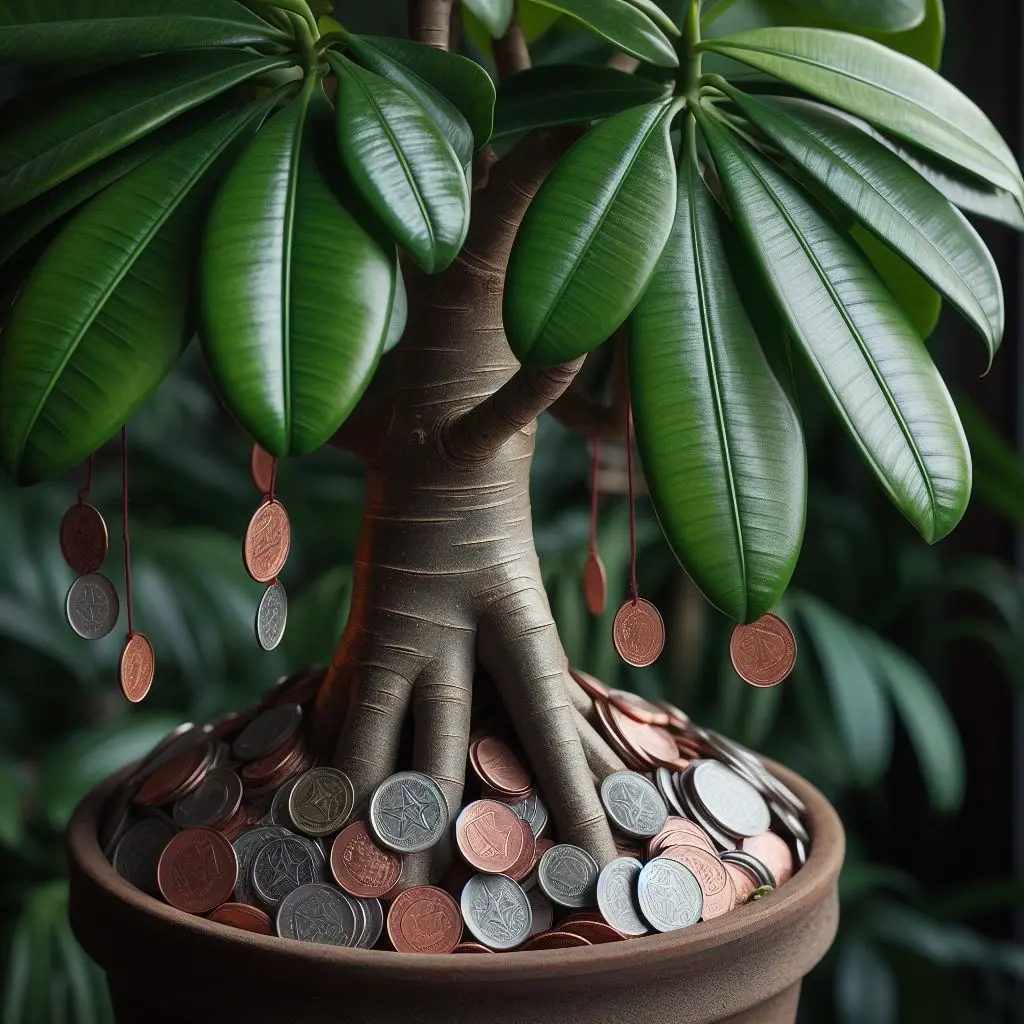
The Pachira plant is a symbol of luck and wealth. If someone in your life has recently started a new business, you can gift them a Money Tree to bring prosperity to their venture.
The leaves of this small tree are vibrant green with an elegant shape, enhancing its overall beauty. The complex and braided trunk of this apartment plant symbolizes aesthetic appeal.
- Maintenance: Easy
- Watering: Moderate to low; overwatering can lead to leaf yellowing.
- Light: Moderate; the best placement is behind a window.
- Soil: A mixture of peat moss and perlite.
- Plant Height: Up to 1.5 meters
The Pachira plant is considered a luxurious addition to indoor plants. Due to its relatively recent introduction to Iran, it comes with a higher price tag.
read more: 15 Safe plants for budgies
If you are among those who care for pets, the Pachira plant is a suitable choice as it doesn’t pose any harm to animals.
| Feature | Specifications |
| Maintenance | Easy |
| Watering | Moderate to low + Overwatering can lead to yellowing of leaves |
| Light | Moderate; best placement is behind a window |
| Soil | Mixture of peat moss + perlite |
| Plant Height | Up to 1.5 meters |
**Yucca Elephantipes (Yucca)**
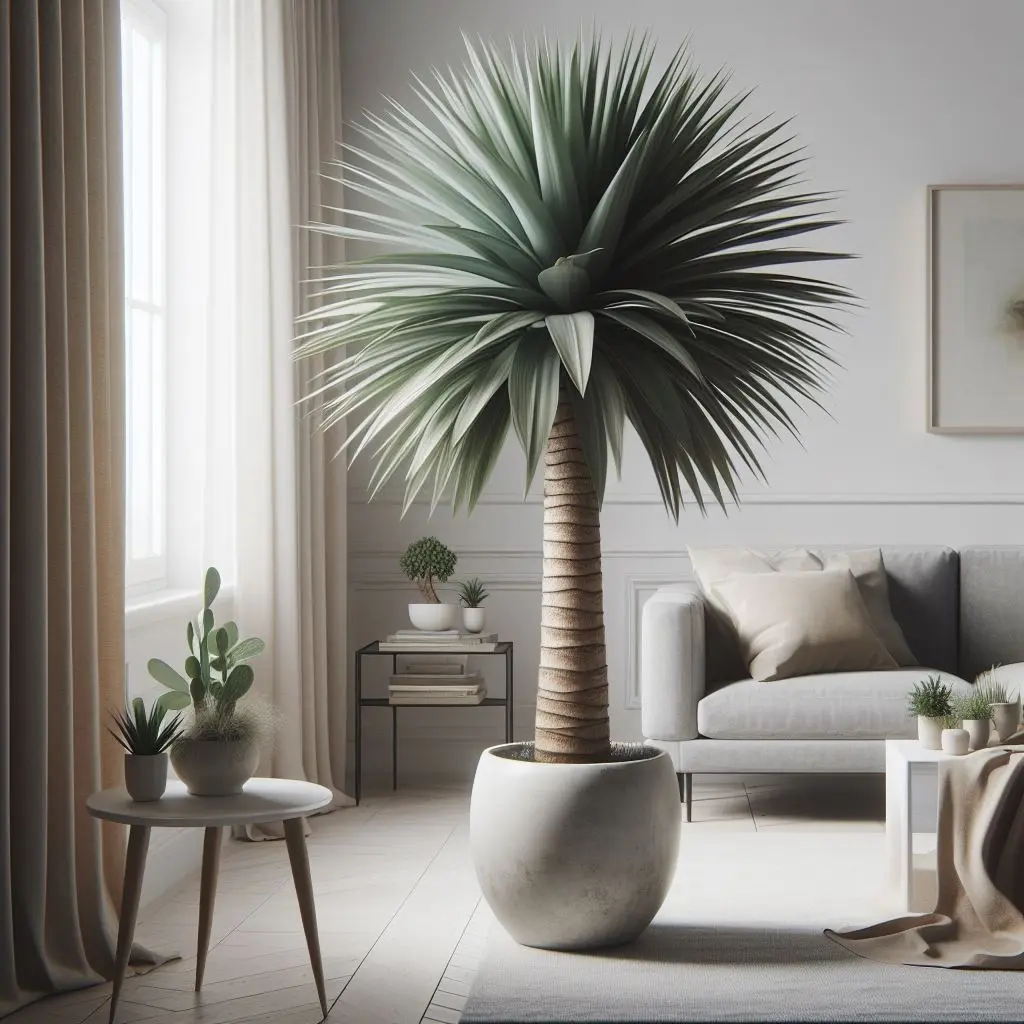
Commonly known as the “Zangololeh” plant, the Yucca’s robust and beautiful trunk is a distinctive feature that contributes unparalleled beauty to these ornamental apartment plants.
Large, sword-shaped leaves are another characteristic of the Yucca. It is a suitable balcony plant that can be easily maintained both indoors and in gardens.
Yucca is among the resilient apartment plants that can be effortlessly used in various environments. It is particularly useful for decorating office spaces.
**Care Information:**
– **Maintenance:** Easy
– **Watering:** Moderate + Allow the soil to dry out between two waterings.
– **Light:** Abundant + Indirect sunlight
– **Soil:** Well-draining + Compost-rich + Lightweight
– **Plant Height:** Yucca comes in various heights, depending on care and species.
If you have pets, it’s essential to be aware that Yucca is toxic. Contact with or ingestion of Yucca can cause digestive issues for animals.
| Feature | Specifications |
| Maintenance | Easy |
| Watering | Moderate + Allow soil to dry out between waterings |
| Light | Abundant + Indirect sunlight |
| Soil | Well-draining + Compost-rich + Lightweight |
| Plant Height | Various heights, depending on care and species |
**Ficus pumila_minima (Creeping Fig)**
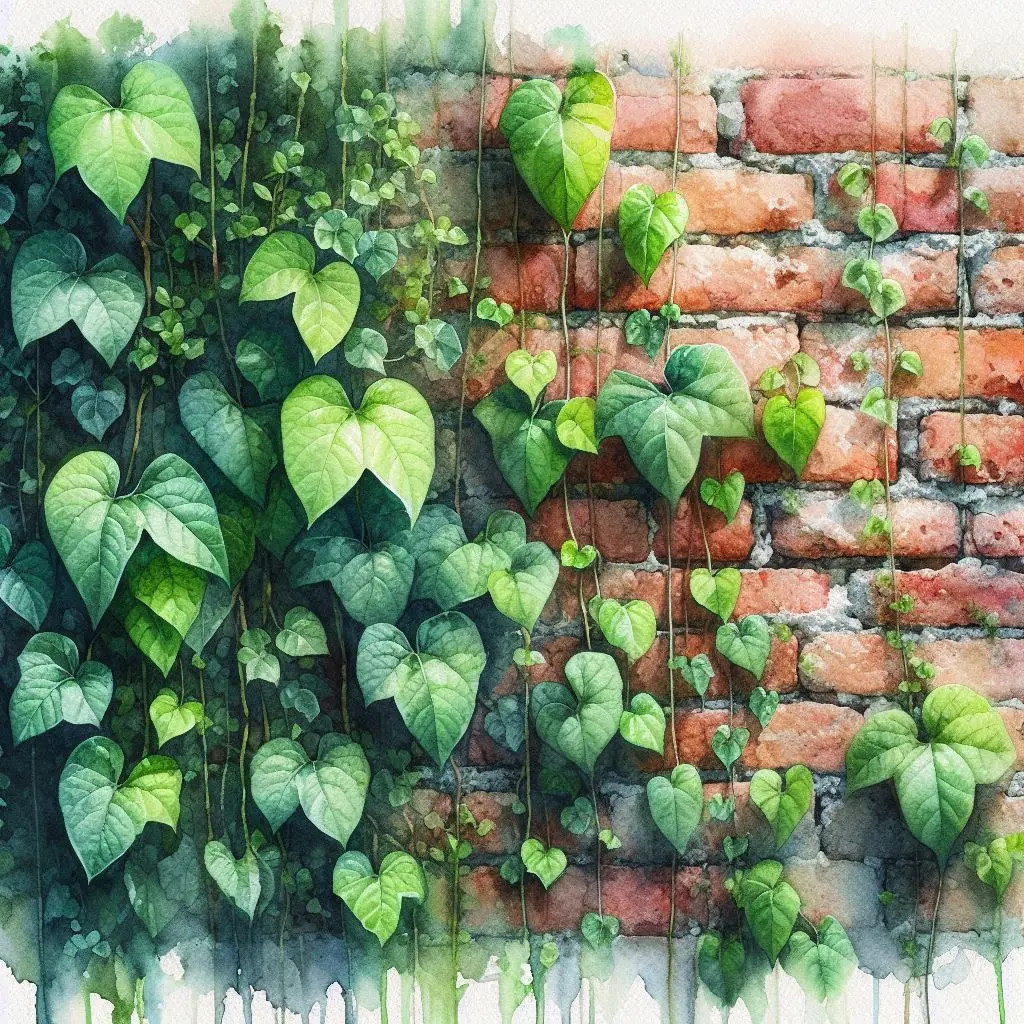
Commonly known as the Creeping Fig, this plant is aptly named for its small leaves. One of the main reasons for choosing the name “small leaves” is the leaf fall during the autumn season. Creeping Fig begins shedding its leaves with the onset of autumn.
– **Maintenance:** Easy and straightforward
– **Watering:** Low to moderate + Touch the soil surface before watering; water if it feels dry.
– **Light:** Bright light + Indirect sunlight
– **Soil:** Garden soil + Composted leaf mold + Organic fertilizer; lightweight, well-draining soil
– **Plant Height:** In outdoor conditions, this plant can reach up to 30 meters in height.
The potted Ficus pumila_minima, also known as Creeping Fig, contains a latex within its leaves that can cause irritation if touched. Be cautious when handling this plant, especially around children and pets. In case of contact and the release of latex, it may lead to symptoms such as diarrhea and vomiting.
| Feature | Specifications |
| Maintenance | Easy and straightforward |
| Watering | Low to moderate + Check soil moisture before watering |
| Light | Bright light + Indirect sunlight |
| Soil | Garden soil + Composted leaf mold + Organic fertilizer; lightweight, well-draining soil |
| Plant Height | Up to 30 meters in outdoor conditions |
**Ficus lyrata (Fiddle Leaf Fig)**

The Ficus lyrata, also known as the Fiddle Leaf Fig, is characterized by its broad leaves. This apartment plant can be kept both indoors and outdoors, with more extensive growth observed when cultivated in an open space.
Apartment plants, like jungle trees, serve as safe havens full of love.
Fall plants like the Fiddle Leaf Fig, particularly during the winter season, contribute to increased humidity, air purification, and a reduction in dust. This helps decrease the prevalence of illnesses, especially colds.
– **Maintenance:** Easy
– **Watering:** Moderate to high + Water whenever the soil becomes dry.
– **Light:** Indirect + Bright light
– **Soil:** Half coarse perlite + Half peat moss
– **Plant Height:** Up to 2 meters in an apartment setting + Up to 12 meters in an outdoor environment
The leaves of this plant are always green, with a distinct 5-lobed and leathery structure, turning the Ficus into a true artistic masterpiece. Bringing a Fiddle Leaf Fig into your home or workplace through plant purchase adds an unparalleled beauty to the surroundings.
| Feature | Specifications |
| Maintenance | Easy |
| Watering | Moderate to high + Water when the soil becomes dry |
| Light | Indirect + Bright light |
| Soil | Half coarse perlite + Half peat moss |
| Plant Height | Up to 2 meters in an apartment setting + Up to 12 meters in an outdoor environment |
**Ficus Elastica (Rubber Plant)**
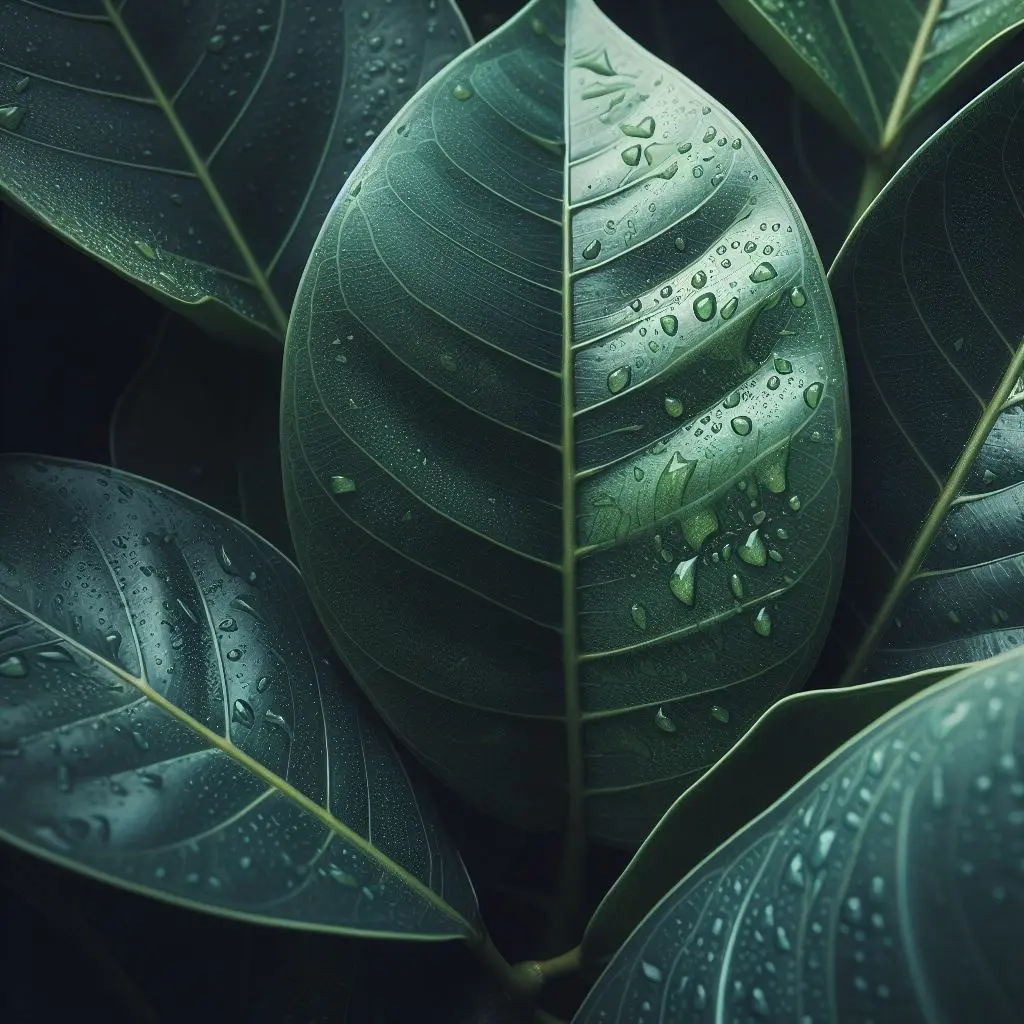
Witness the utmost charm in the Rubber Plant, Ficus Elastica. This resilient apartment plant, with its leather-like leaves, captivates hearts with its exquisite beauty. The Rubber Plant is among the most beloved apartment trees.
Native to India, this plant is part of the tropical flora. Despite some expensive apartment plants, such as Ficus Elastica, being easy to care for, it’s essential to pay attention to the plant’s humidity requirements.
– **Maintenance:** Easy + Requires pruning
– **Watering:** Moderate + Check the potting soil before watering; if it’s dry, it’s time to water.
– **Light:** Abundant + Indirect sunlight
– **Soil:** Lightweight + Well-draining
– **Plant Height:** Up to 1 to 2 meters
Whenever the plant grows tall and large, replace its pot to provide space for the roots to continue growing.
| Feature | Specifications |
| Maintenance | Easy + Requires pruning |
| Watering | Moderate + Check potting soil before watering |
| Light | Abundant + Indirect sunlight |
| Soil | Lightweight + Well-draining |
| Plant Height | Up to 1 to 2 meters |
**Dracaena studnerii (Dragon Tree)**

The Dragon Tree is a house guardian adorned with sharp and slender leaves. The tips of the dragon’s leaves are red, adding a stunning beauty to this ornamental tree. This resilient apartment plant is also known by the name “Dracaena Deremensis.”
The Dragon Tree is a low-light-resistant apartment plant; however, it should be protected from direct sunlight as exposure can harm the plant.
– **Maintenance:** Moderate + Requires occasional dusting
– **Watering:** Moderate + Water whenever the potting soil becomes dry
– **Light:** Low + Indirect sunlight
– **Soil:** Garden soil mixture + Leaf mold + Compost
– **Plant Height:** Can reach up to 2 meters in height
This large apartment tree requires bi-weekly dusting to keep its leaves free from dust and debris. The Dragon Tree is among the large apartment plants suitable for decoration and design in various environments.
| Feature | Specifications |
| Maintenance | Moderate + Requires occasional dusting |
| Watering | Moderate + Water whenever the potting soil becomes dry |
| Light | Low + Indirect sunlight |
| Soil | Garden soil mixture + Leaf mold + Compost |
| Plant Height | Can reach up to 2 meters in height |
**Musa spp (Banana Tree)**
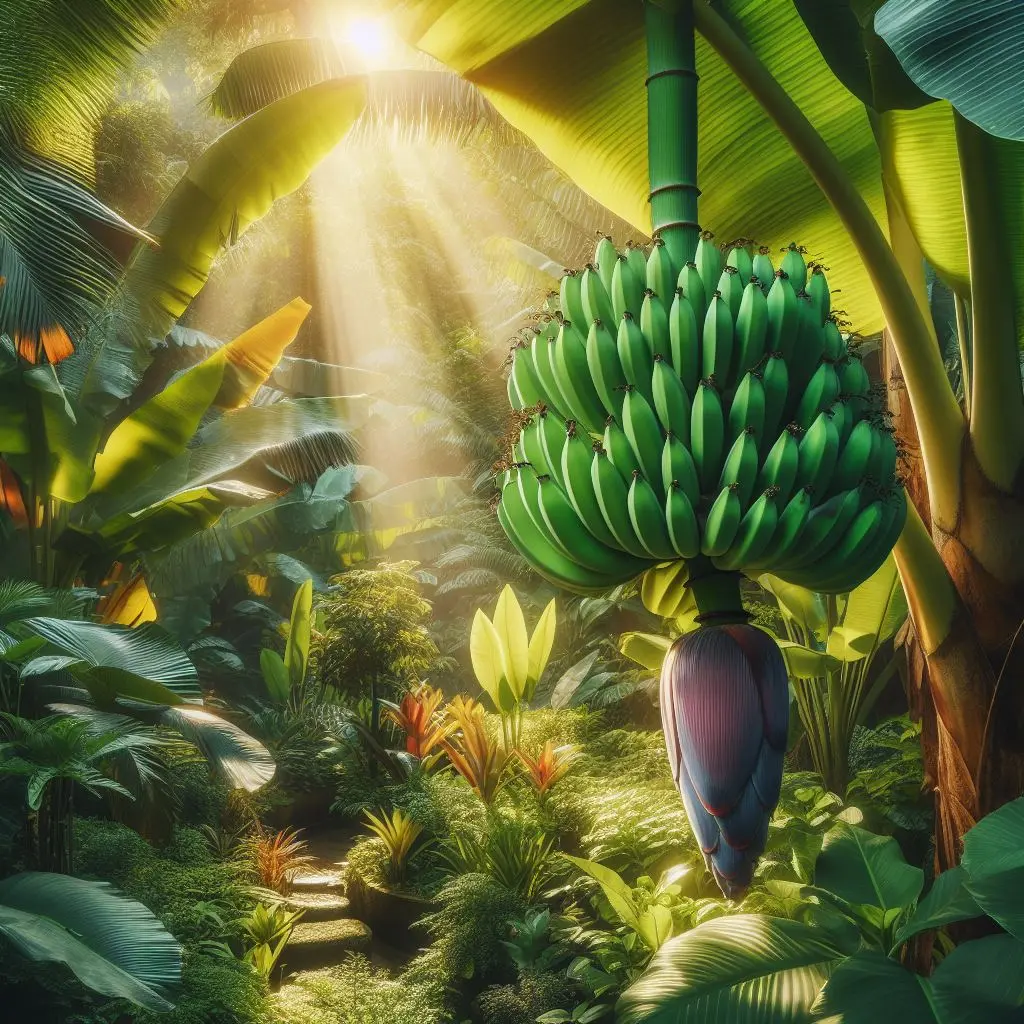
Hit two birds with one stone; not only keep a fruit-bearing Banana Tree as an apartment fruit plant but also enhance the home environment with its aesthetic appeal.
Banana trees are among the best broad-leafed apartment plants. If you need plants with broad leaves for home design, the Banana Tree is an excellent choice.
Keep in mind that not all species of banana trees bear fruit. Below are two varieties of this plant:
– Cavendish: Fruit-bearing variety
– Japanese Banana (Musa basjoo): Non-fruit-bearing variety
If you intend to care for this species, it’s advisable to choose dwarf varieties, as they are more manageable in terms of height.
– **Maintenance:** Easy
– **Watering:** Moderate + 3 times a week in summer + Once a week in winter
– **Light:** Full sunlight
– **Soil:** Acidic + Adequate drainage
– **Plant Height:** Up to 9 meters
When selecting a pot for fruit-bearing apartment plants, consider the size of the plant to avoid damaging its roots. Larger-sized plants are more prone to damage due to their larger leaves. Before purchasing large apartment plants, ensure you have enough space to accommodate them.
| Feature | Specifications |
| Maintenance | Easy |
| Watering | Moderate + 3 times a week in summer + Once a week in winter |
| Light | Full sunlight |
| Soil | Acidic + Adequate drainage |
| Plant Height | Up to 9 meters |
**Ficus Binnendijkii (Amstel King)**

The Amstel King plant, also known as Amstel, is suitable for both apartment and outdoor spaces.
This apartment tree is among the non-flowering plants, featuring thin and very tall leaves. Caring for this resilient apartment plant is not difficult; you just need to follow a few tips mentioned below:
– **Maintenance:** Moderate
– **Watering:** Twice a week + Check soil dryness before watering
– **Light:** Abundant + Indirect sunlight
– **Soil:** Garden soil + Sand + Perlite + Humus
– **Plant Height:** Indoors 3 to 4 meters + Outdoors up to 20 meters
One of the most significant benefits of the Ficus Binnendijkii is its air-purifying properties, contributing to increased humidity and clean air in the environment.
| Feature | Specifications |
| Maintenance | Moderate |
| Watering | Twice a week + Check soil dryness before watering |
| Light | Abundant + Indirect sunlight |
| Soil | Garden soil + Sand + Perlite + Humus |
| Plant Height | Indoors 3 to 4 meters + Outdoors up to 20 meters |
**Ponytail Palm Tree (Beaucarnea recurvata)**
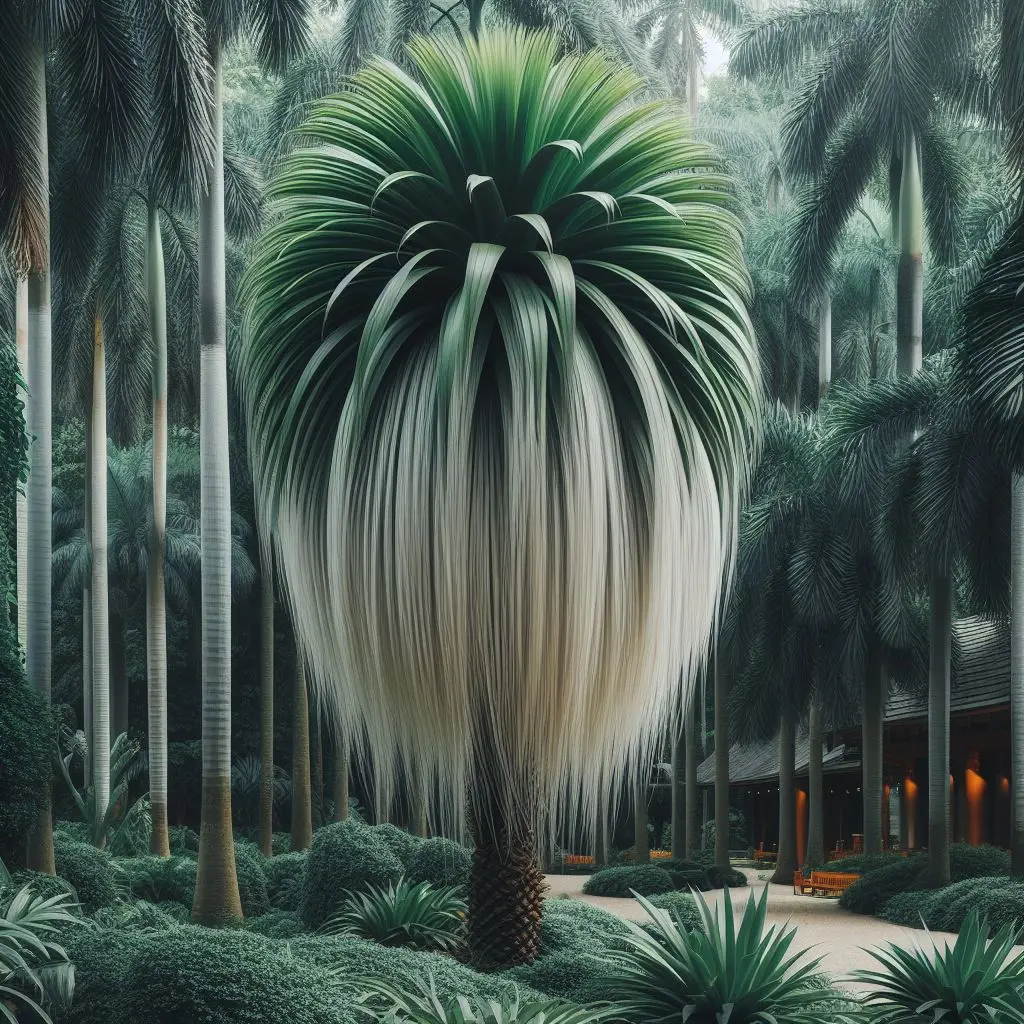
The Ponytail Palm Tree, also known as Pony Tail, Elephant Foot, or Bottle Palm, is characterized by its ribbon-like leaves. If you haven’t seen this plant up close, you can imagine a smaller-sized crazy ponytail palm tree. This image captures the true essence of the Ponytail Palm.
– **Maintenance:** Moderate
– **Watering:** Low + Check the top few centimeters of soil before watering
– **Light:** Indirect + Full light
– **Soil:** Well-draining + Sandy soil
– **Plant Height:** Up to 2 meters
This apartment tree is known for its resilience, but it lacks sufficient resistance to cold temperatures. It’s advisable to protect Ponytail Palms from the cold to prevent diseases and damage.
The Ponytail Palm has slow growth and an exceptionally long lifespan, making it suitable for home décor, providing enjoyment for many years.
| Feature | Specifications |
| Maintenance | Moderate |
| Watering | Low + Check top soil before watering |
| Light | Indirect + Full light |
| Soil | Well-draining + Sandy soil |
| Plant Height | Up to 2 meters |
“9- Umbrella Tree (Schefflera Arboricola)
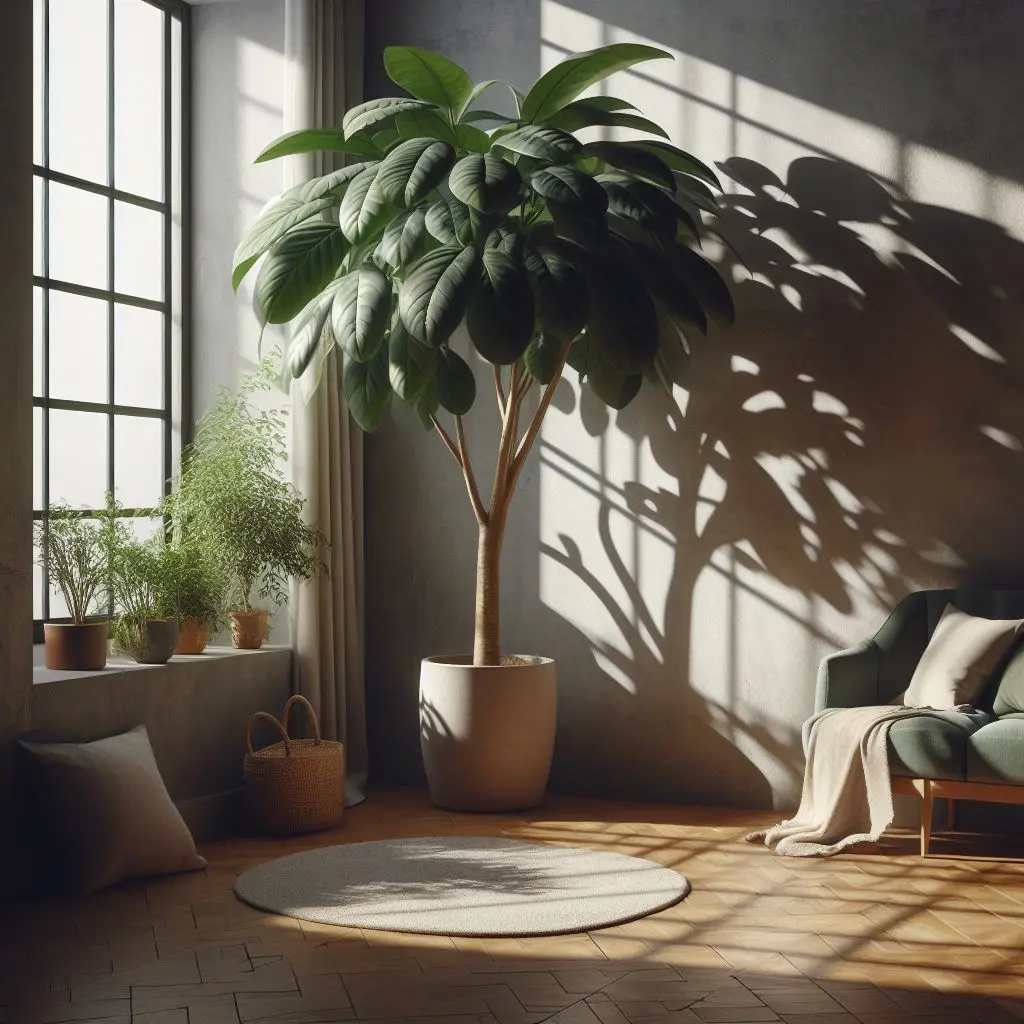
The Schefflera, also known as the Umbrella Tree, is a captivating species and ranks among the best indoor plants. Its leaves come in a variety of vibrant and appealing colors, with the umbrella variety being one of the most popular. The name Schefflera Arboricola is also used for this species, referring to the type of foliage it exhibits.
- Maintenance Level: Moderate + Requires occasional dusting
- Watering: Bi-weekly in summer + Weekly in winter, check soil dryness before watering
- Light: Indirect sunlight
- Soil: Combination of coco peat, leaf soil, and peat moss
- Plant Height: Up to approximately three meters
If you are a working woman or find yourself away from home frequently due to your job, you can easily maintain the Umbrella Tree. Schefflera is considered one of the most resilient indoor plants, making it highly suitable for individuals with limited time for plant care.”
| Characteristic | Care Information for Umbrella Tree |
| Maintenance Status | Moderate to easy and adaptable |
| Watering | Moderate, allowing the topsoil to dry between waterings |
| Light | Moderate to bright light, but avoid direct sunlight |
| Soil | Well-draining, using a mix of potting soil with good drainage |
| Plant Height | Typically thrives better in warmer temperatures and with proper light |
**10- Aucuba Apartment Plant (Japanese Laurel)**
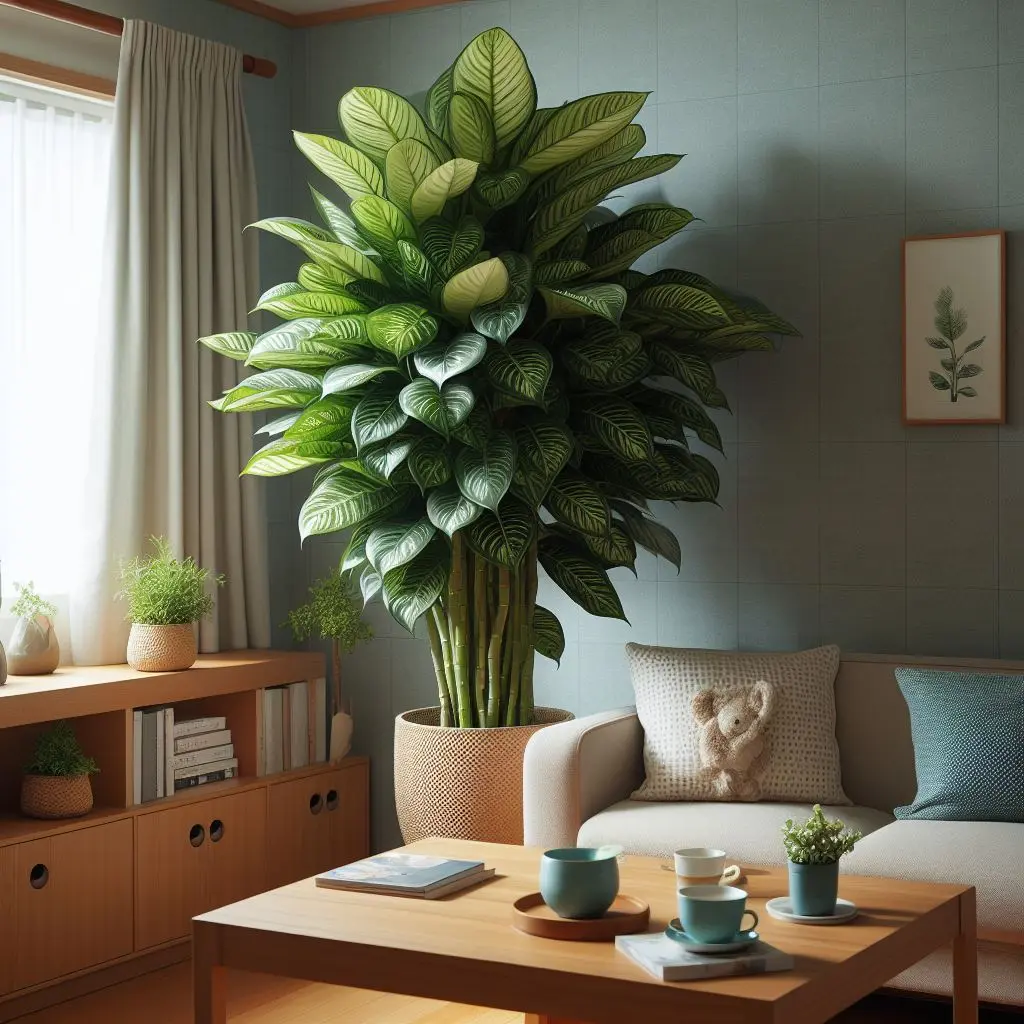
The colloquial name for the Aucuba plant is the Japanese Laurel. This low-light apartment plant thrives effortlessly in environments with minimal light. The plant comes in two varieties: variegated and simple. The variegated type exhibits yellow hues within, resembling closely to croton plants.
– **Maintenance Status:** Moderate
– **Watering:** Moderate, check the soil dryness before each watering.
– **Light:** Low to moderate
– **Soil:** Well-draining, lightweight soil
– **Plant Height:** Up to 1.5 meters
Caution: Handling this plant requires care, especially if there are children or pets around. Aucuba is considered toxic to dogs and humans. Ingestion or contact may lead to illness or poisoning.
| Characteristic | Care Information for Aucuba (Japanese Laurel) |
| Common Name | Aucuba, also known as Japanese Laurel |
| Maintenance Status | Moderate |
| Watering | Moderate, check soil dryness before watering |
| Light | Low to moderate |
| Soil | Well-draining, lightweight soil |
| Plant Height | Up to 1.5 meters |
| Caution | Caution: The plant is toxic to children and pets. Ingestion or contact can lead to illness or poisoning, as it is considered toxic to dogs and humans. Handle with care. |
**11- Monstera Deliciosa (Swiss Cheese Plant)**
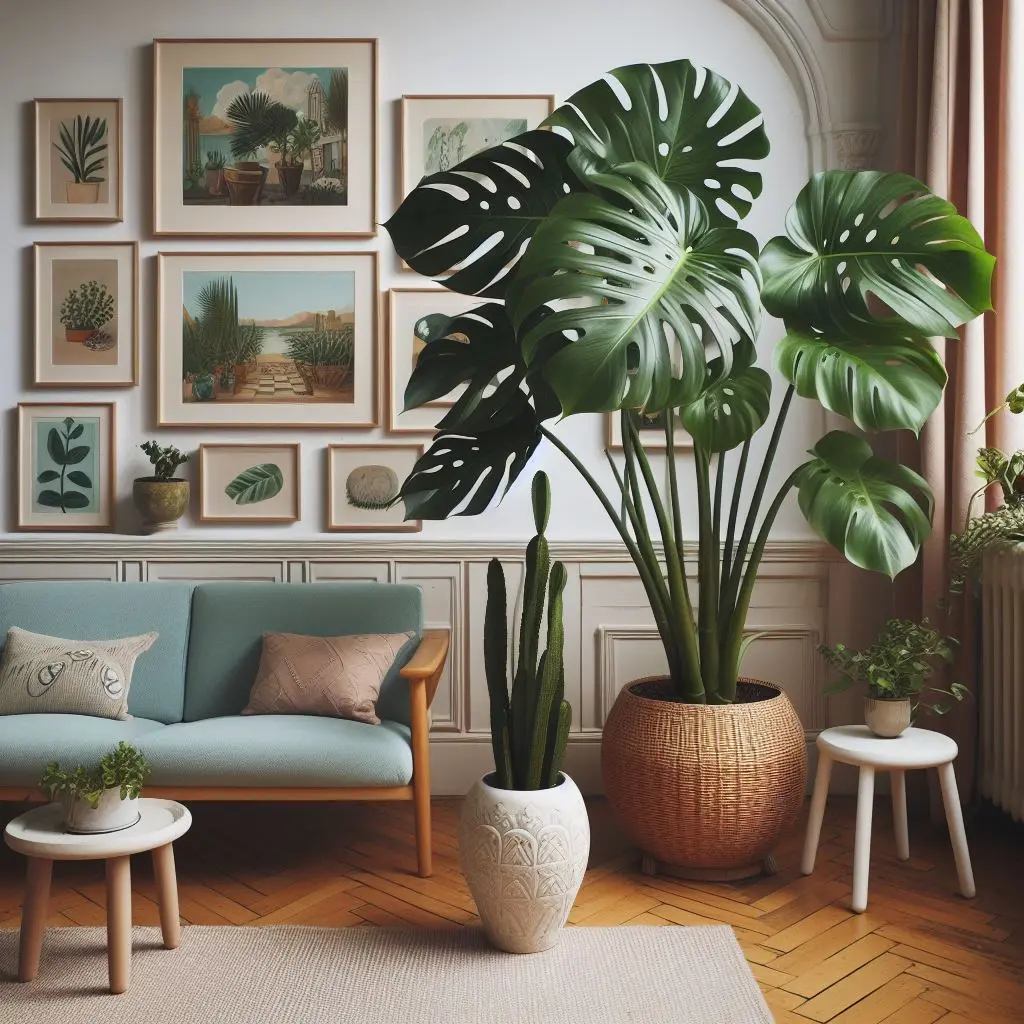
The Monstera Deliciosa, commonly known as the Swiss Cheese Plant, is an apartment flower with a preference for shade and sensitivity to direct sunlight. It thrives in environments where sunlight reaches it indirectly.
The distinctive appearance of the Monstera leaves makes it a globally recognized plant, adding a captivating touch to any space through the purchase of various floral varieties.
– **Maintenance Status:** Moderate
– **Watering:** Moderate, check the soil up to 2 to 3 centimeters before watering.
– **Light:** Shade-tolerant
– **Soil:** Well-draining, lightweight soil
– **Plant Height:** In outdoor settings, Monstera Deliciosa can grow up to 30 meters.
Monstera Deliciosa is considered a toxic apartment plant. It is advisable to handle it with care and keep it out of reach of children and pets, as contact or ingestion may lead to illness or poisoning.
| Characteristic | Care Information for Monstera Deliciosa (Swiss Cheese Plant) |
| Maintenance Status | Moderate |
| Watering | Moderate, check soil up to 2-3 centimeters before watering |
| Light | Shade-tolerant |
| Soil | Well-draining, lightweight soil |
| Plant Height | In outdoor settings, Monstera Deliciosa can grow up to 30 meters |
12- Madagascar Palm Apartment Plant
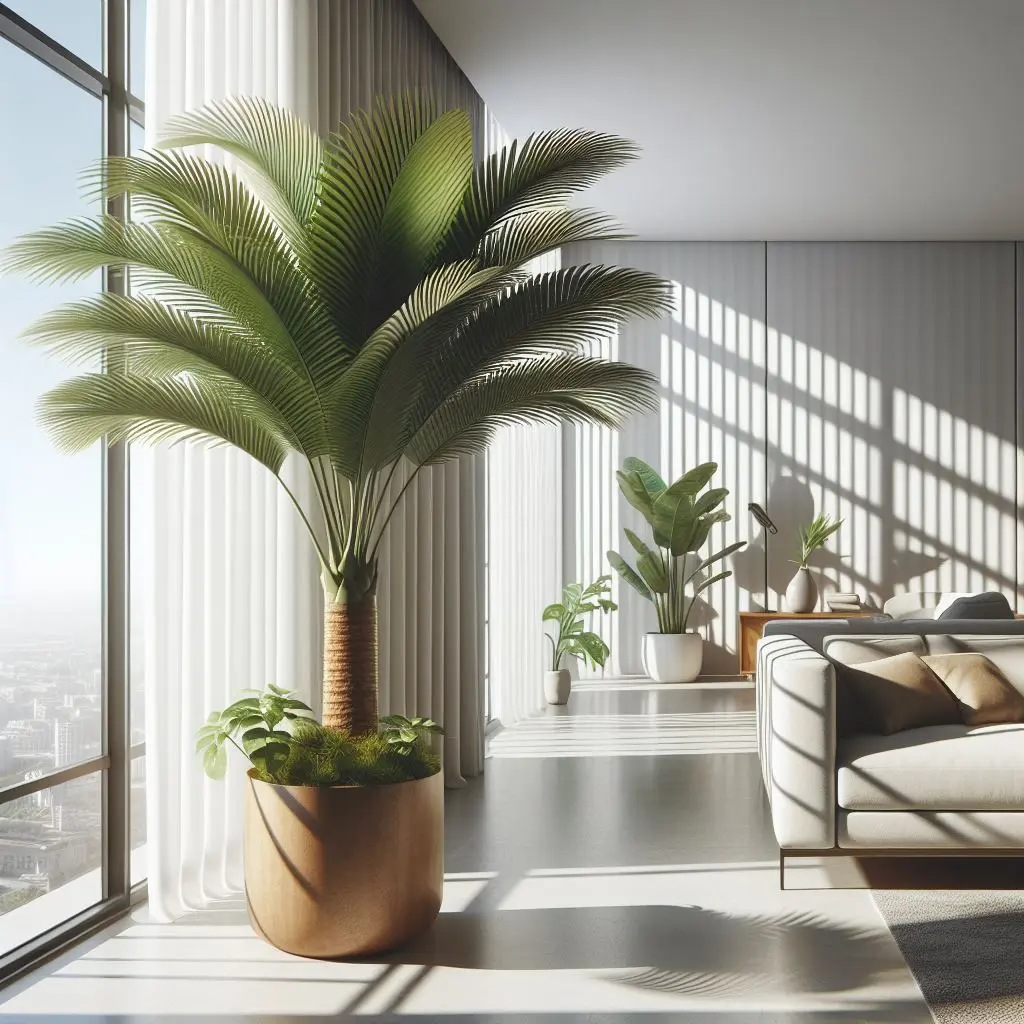
Invite the jungles of Madagascar into your space. The cultivation of these tree-like flowers is prevalent worldwide, with many individuals choosing to care for them due to their striking beauty. Alongside their captivating appearance, these plants are also known for their easy maintenance, making them a preferred choice for individuals with limited time for plant care.
- Maintenance Status: Moderate
- Watering: Abundant
- Light: Bright + Direct sunlight
- Soil: Well-draining, lightweight soil
- Plant Height: Up to 6 meters
Caution: When tending to these apartment trees, be aware of their toxic nature. It’s best to keep them in a location inaccessible to children or pets to prevent potential poisoning.
| Characteristic | Care Information for Madagascar Palm |
| Maintenance Status | Moderate |
| Watering | Abundant |
| Light | Bright + Direct sunlight |
| Soil | Well-draining, lightweight soil |
| Plant Height | Up to 6 meters |
13- Adenium Apartment Plant
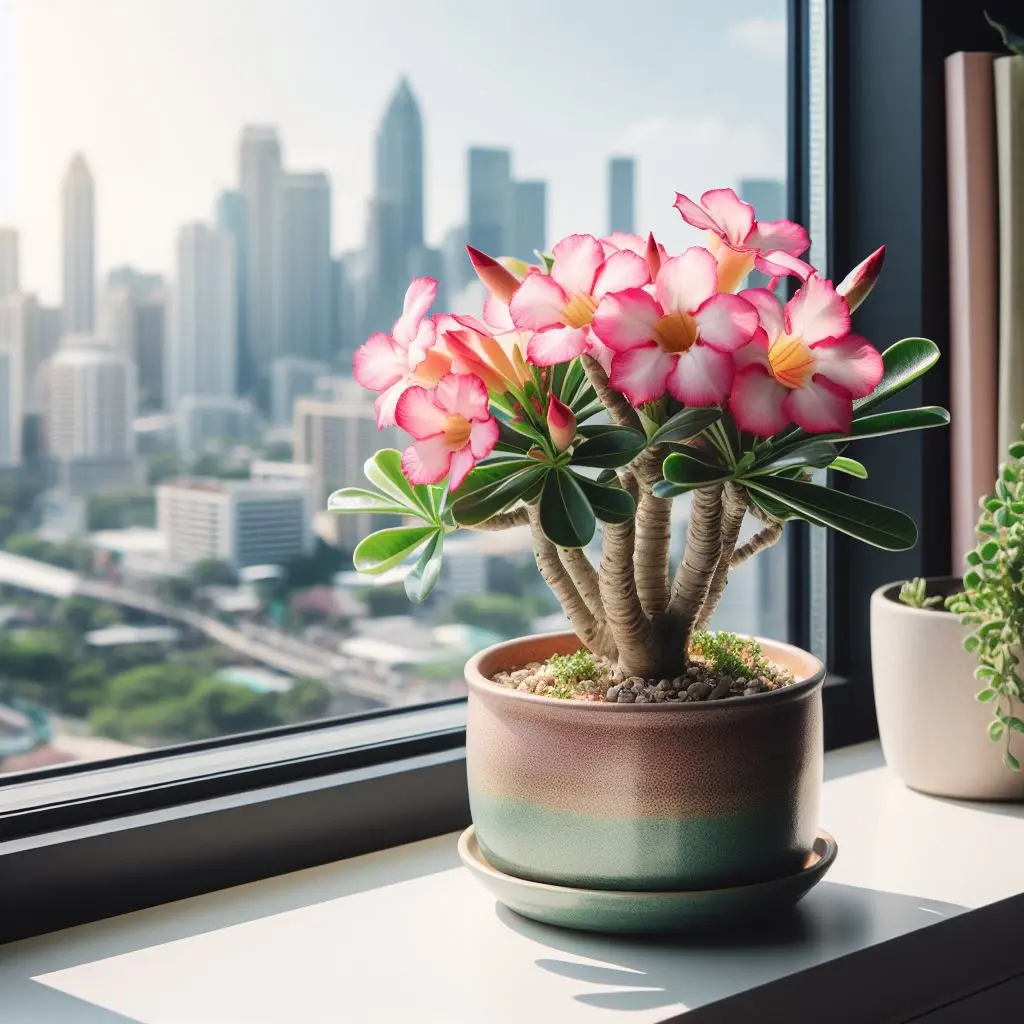
If someone in your life is eager to witness wealth and success up close, the best purchasing decision is the Adenium plant. This shrub symbolizes prosperity, increased blessings, and livelihood.
- Maintenance Status: Moderate
- Watering: In the early days, water the plant daily. As it matures, reduce the frequency of watering.
- Light: Moderate + Direct sunlight
- Soil: A mix of vermiculite, sand compounds, and cactus soil
- Plant Height: With proper care, it can reach up to 4.5 meters.
The Adenium home plant belongs to the Apocynaceae family and is considered toxic, including its sap. It should not be in contact with children or household pets.
It might be interesting to note that in ancient times, Adenium sap was used as poison for hunting animals.
| Characteristic | Care Information for Adenium Apartment Plant |
| Maintenance Status | Moderate |
| Watering | In the early days, daily watering; as it matures, reduce frequency |
| Light | Moderate + Direct sunlight |
| Soil | A mix of vermiculite, sand compounds, and cactus soil |
| Plant Height | With proper care, it can reach up to 4.5 meters |
14- Bamboo Apartment Plant
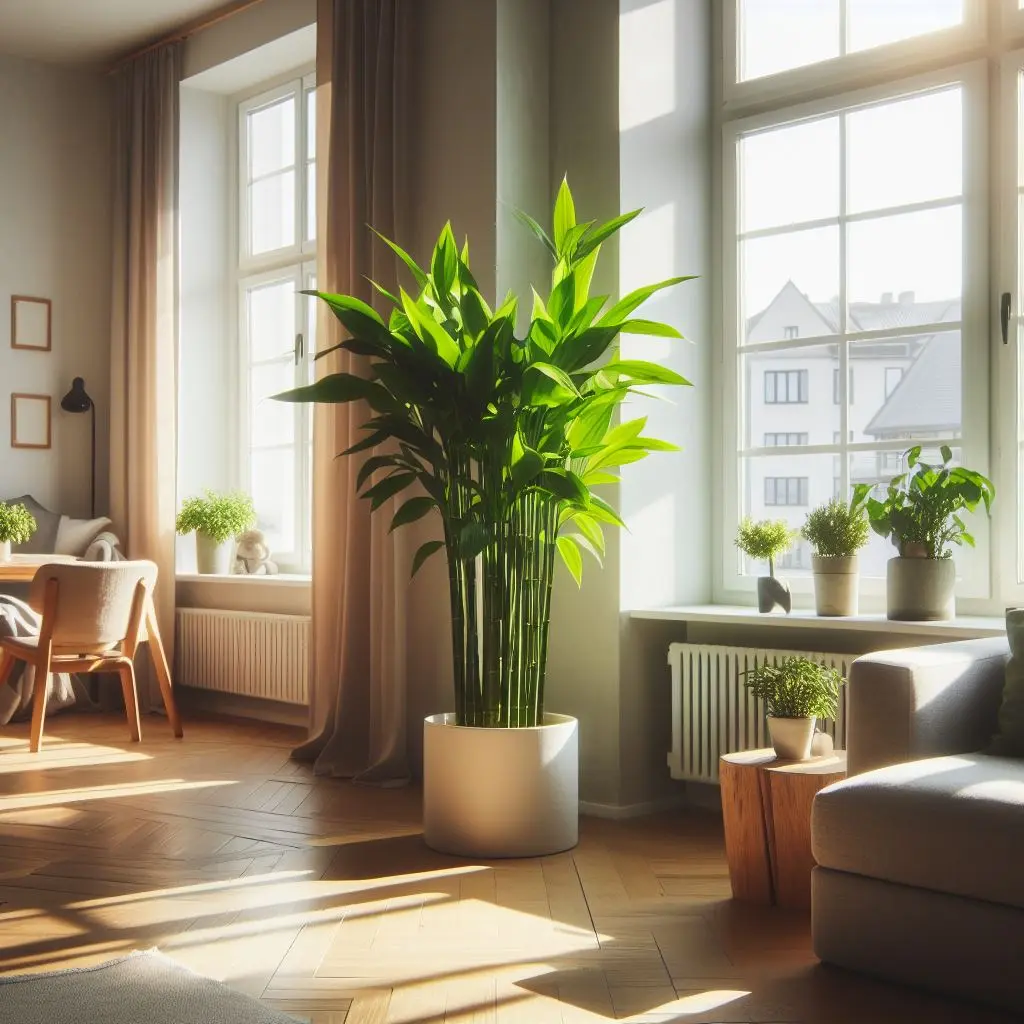
Bamboo opens the door to luck in your home. Bamboo has two different species that can be kept in apartments, each with a beautiful and enticing appearance:
- Lucky Bamboo
- Bamboo Dracaena
These apartment tree flowers require humidity, and one factor that aids in their growth is occasional misting.
- Maintenance Status: Easy
- Watering: Moderate + Begin watering when the bamboo soil is dry.
- Light: Moderate + Indirect sunlight
- Soil: Pebbles + Potting mix + Loamy soil
- Plant Height: In its natural habitat, it can grow up to 40 meters. With proper care in an apartment, it can still thrive.
The presence of bamboo in your home not only injects a sense of happiness into the space but also makes the environment visually appealing.
| Characteristic | Care Information for Bamboo Apartment Plant |
| Maintenance Status | Easy |
| Watering | Moderate + Begin watering when the bamboo soil is dry |
| Light | Moderate + Indirect sunlight |
| Soil | Pebbles + Potting mix + Loamy soil |
| Plant Height | In its natural habitat, it can grow up to 40 meters. With proper care in an apartment, it can still thrive. |
**15- Neanthebella Palm**
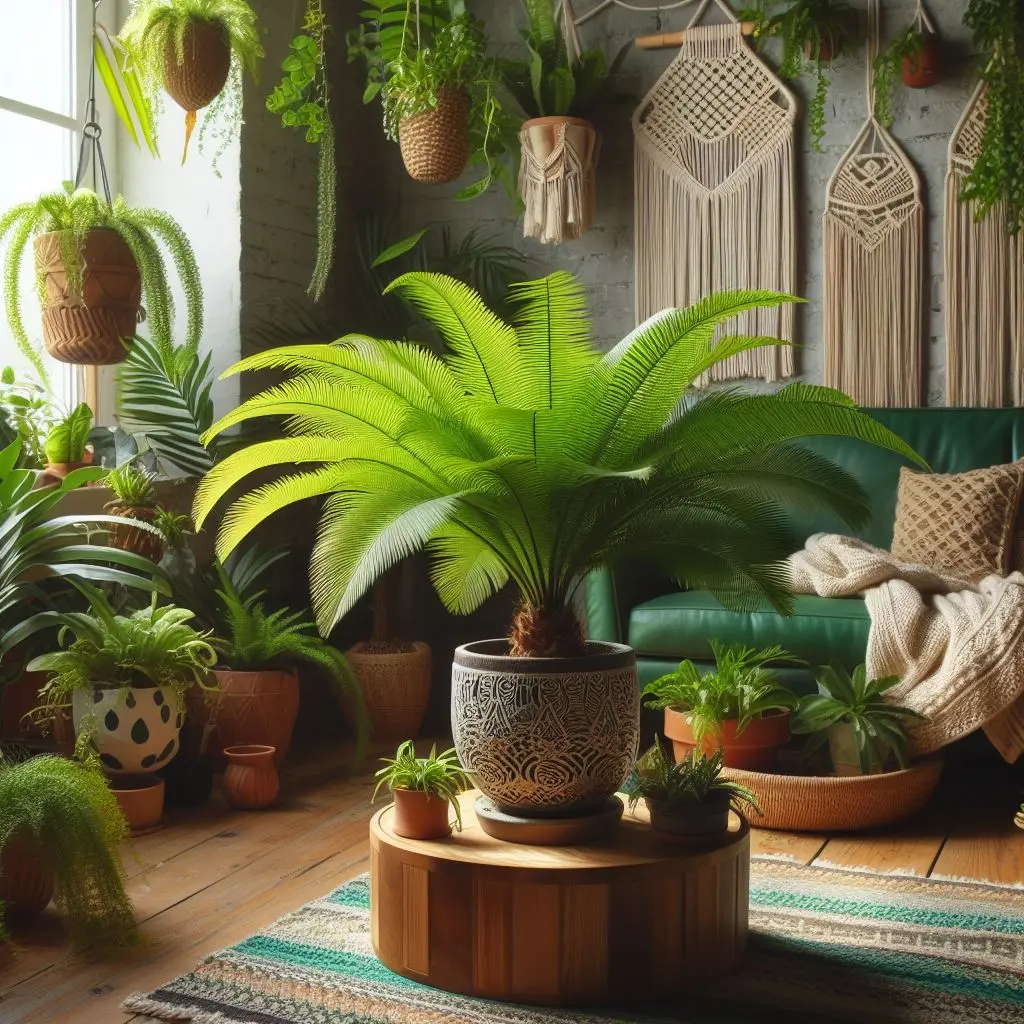
This species is the smallest among palms and is listed among air-purifying plants. Neanthebella contributes to air purification by eliminating environmental pollutants and increasing air humidity.
– **Maintenance Status:** Moderate
– **Watering:** Moderate + Check the plant’s soil before watering; if it’s dry, it’s time to water.
– **Light:** Low-light apartment plant + Indirect sunlight
– **Soil:** Well-draining + Lightweight soil
– **Plant Height:** Up to one to two meters
Neanthebella Palm is a type of potted plant that grows slowly and steadily. Avoid hurrying to replace its pot, as it should be changed only once every two to three years.
If the well-being of your Neanthebella Palm is essential, avoid placing it in direct exposure to an air cooler.
| Characteristic | Care Information for Neanthebella Palm |
| Maintenance Status | Moderate |
| Watering | Moderate + Check soil moisture before watering |
| Light | Low-light apartment plant + Indirect sunlight |
| Soil | Well-draining + Lightweight soil |
| Plant Height | Up to one to two meters |
**16- Kentia Palm**
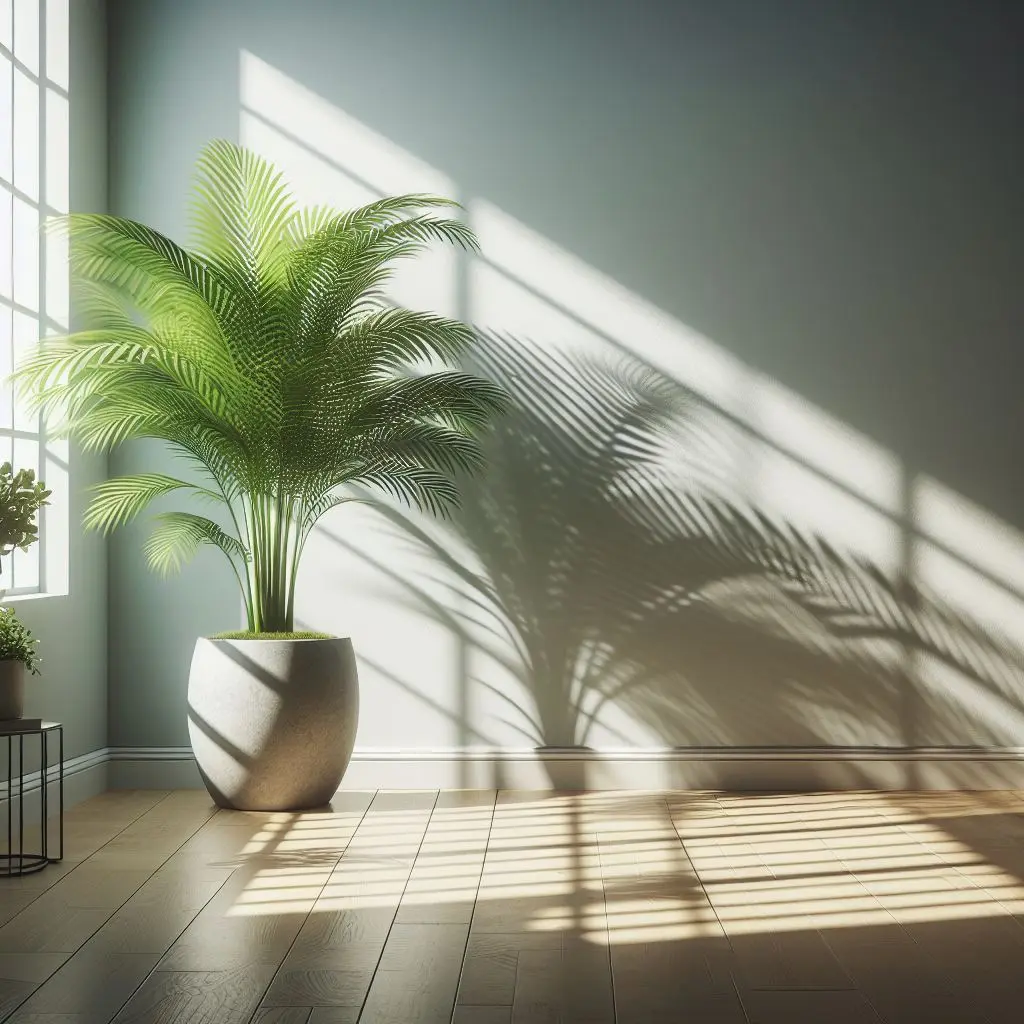
Purchasing luxurious and upscale apartment plants for your home will make your living space dreamy and minimalistic. If you want your home to have a different atmosphere, buying a Kentia palm is a very suitable option.
Taking care of this Kentia apartment plant is not difficult and challenging; with a few key characteristics, its needs can be easily met.
– **Maintenance Status:** Moderate
– **Watering:** In warm seasons, initiate watering when the top 2-3 cm of soil dries out. In cold seasons, begin watering when the top 4-5 cm of soil dries out.
– **Light:** Bright + Indirect sunlight
– **Soil:** Lightweight + Well-draining soil
– **Plant Height:** Typically ranges between 3 to 3.5 meters in an apartment.
The growth of the Kentia plant is very slow and steady, making it an excellent choice for offices. It doesn’t pose the hassle of pot replacement and continues its life with minimal care.
| Characteristic | Care Information for Kentia Palm |
| Maintenance Status | Moderate |
| Watering | In warm seasons, start watering when the top 2-3 cm of soil dries out. In cold seasons, begin watering when the top 4-5 cm of soil dries out. |
| Light | Bright + Indirect sunlight |
| Soil | Lightweight + Well-draining soil |
| Plant Height | Typically ranges between 3 to 3.5 meters in an apartment |
**17- Norfolk Island Pine**
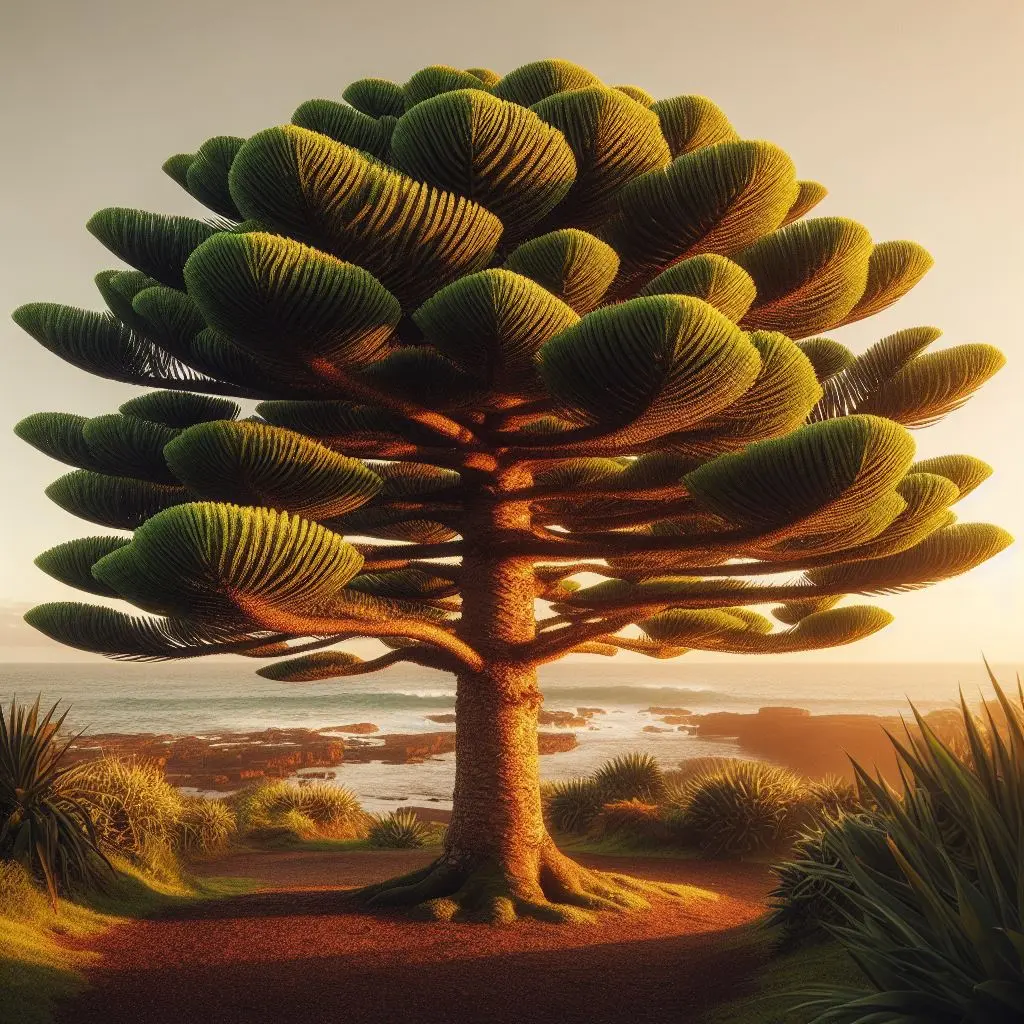
Luxurious trees like the Norfolk Island Pine come with a hefty price tag, and the reason for the high cost of this apartment tree lies in the challenging propagation and bushy growth. Therefore, this plant is among the ornamental apartment trees that add a chic and luxurious touch to your home.
– **Maintenance Status:** Difficult
– **Watering:** Abundant watering is required. In warm seasons, water every two days, and in cooler seasons, water every 10 days.
– **Light:** This apartment tree thrives in both bright light and shade.
– **Soil:** Compost soil + Well-draining + Lightweight
– **Plant Height:** Up to 2 meters in an apartment.
The roots of the Norfolk Island Pine are highly sensitive. Therefore, try to use boiled water or water that has been left to stand for some time to eliminate water impurities and keep the plant’s roots healthy.
| Characteristic | Care Information for Norfolk Island Pine |
| Maintenance Status | Difficult |
| Watering | Abundant + In warm seasons, water every two days. In cooler seasons, water every 10 days. |
| Light | Thrives in both bright light and shade |
| Soil | Compost soil + Well-draining + Lightweight |
| Plant Height | Up to 2 meters in an apartment |
**18- Jade Plant (Crassula ovata)**
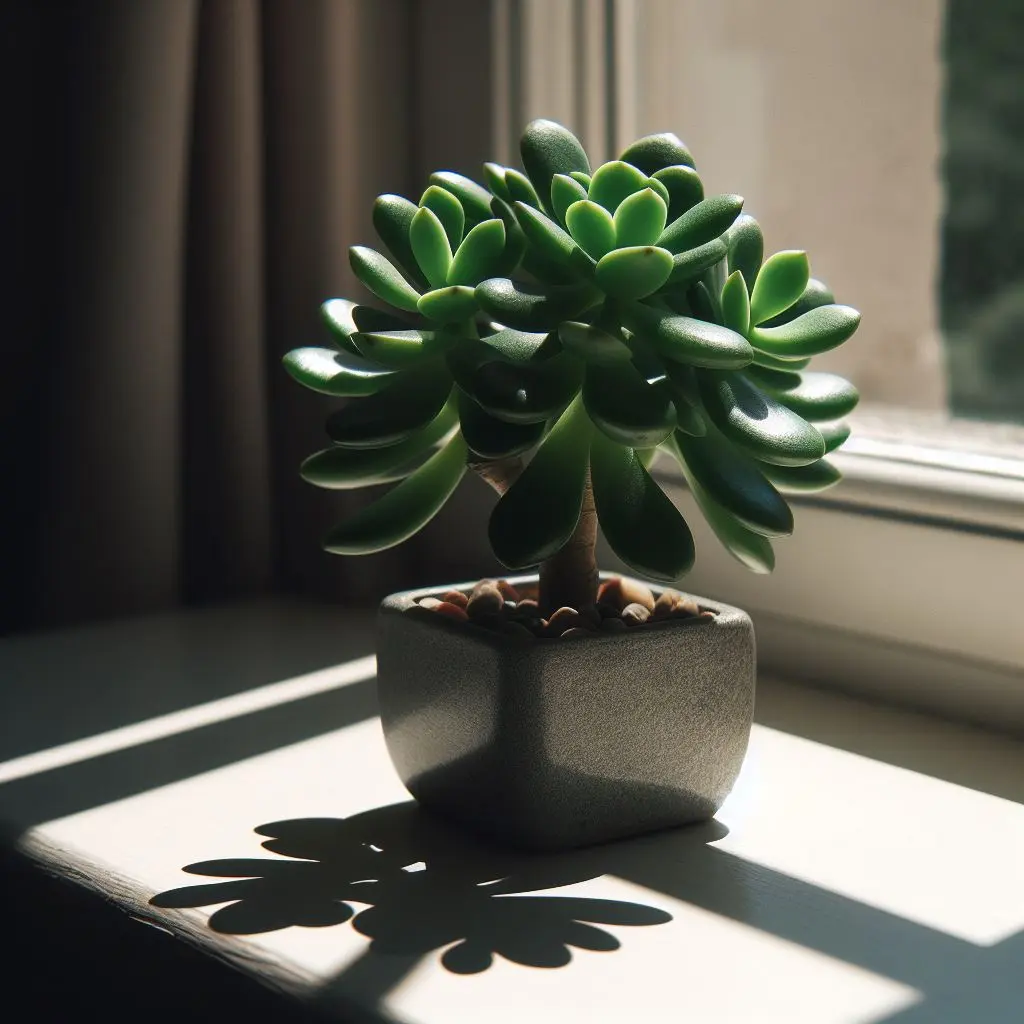
The Jade Plant, or Crassula ovata, is named after the predominant color of its leaves, resembling jade. The leaves of the Jade Plant are fleshy and egg-shaped. It is among the most resilient apartment trees, exhibiting remarkable longevity, making it suitable for any indoor environment.
This apartment plant is known by various names, such as Money Plant, Lucky Plant, and Dollar Plant. If you have limited time for plant care, it’s better to opt for low-maintenance plants. Crassula is one of these plants, and with just a few tips, you can easily take care of it.
– **Maintenance Status:** Easy
– **Watering:** Regular watering + More frequent watering in warm seasons + Controlled watering in cold seasons (Be cautious not to overwater)
– **Light:** Bright + Indirect sunlight
– **Soil:** Well-draining + Lightweight soil
– **Plant Height:** With proper care, it can reach a height of 1 to 3 meters after several years.
If you notice leaf shedding during maintenance, reconsider your care routine. The primary cause of Jade Plant leaf shedding is underwatering.
| Characteristic | Care Information for Jade Plant (Crassula ovata) |
| Maintenance Status | Easy |
| Watering | Regular watering + More frequent in warm seasons + Controlled in cold seasons (Avoid overwatering) |
| Light | Bright + Indirect sunlight |
| Soil | Well-draining + Lightweight soil |
| Plant Height | With proper care, can reach 1 to 3 meters after several years |
19- **Screw Pine (Pandanus) Indoor Plant**
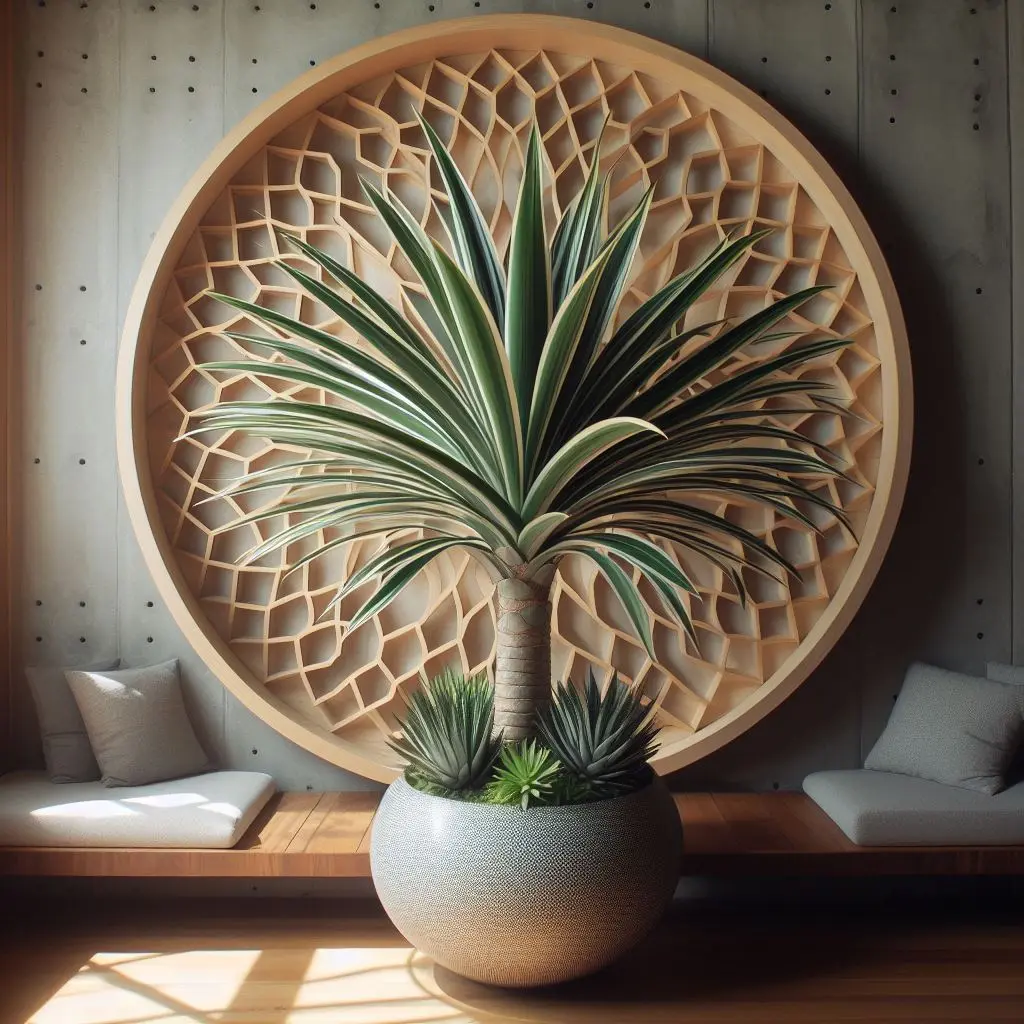
The plant known as Pandanus is also referred to as the screw pine.
This plant has a long lifespan, and with proper care and maintenance, its growth can be encouraged. There are various species of screw pines, and if these shrub-like flowers are kept in their natural environment, they can reach a height of up to 1.5 meters.(they can reach to 1.5 meters height.)
The leaves of Pandanus are very thin and tall, with edges in cream or white, enhancing the plant’s beauty several times over.
– Maintenance Status: Moderate
– Watering: Low and controlled + every 10 days in the warm season + every two weeks in the cold season
– Light: Moderate + indirect
– Soil: Combination of sand and peat + light and well-draining soil + regular fertilization
– Plant Height: Up to 1.5 meters
One notable characteristic of the Pandanus plant is its pineapple-like appearance, where the leaves encircle the plant from top to bottom. When caring for Pandanus, attention should be given to replacing the pot; it is recommended to change the pot once a year to provide ample space for root growth.
| Characteristic | Details |
| Maintenance Status | Moderate |
| Watering | Low and controlled + every 10 days in the warm season + every two weeks in the cold season |
| Light | Moderate + indirect |
| Soil | Combination of sand and peat + light and well-draining soil + regular fertilization |
| Plant Height | Up to 1.5 meters |
| Special Feature | Pineapple-like appearance, with leaves encircling the plant; recommended to change the pot annually |
20- **Areca Palm (Areca lutescens)**

Commonly known as the butterfly palm, the Areca palm features large, feathery leaves that are resistant to cold, making it suitable for regions with a Mediterranean climate. One distinctive visual characteristic of the Areca palm is the growth of white, thread-like strands around its leaves.
– **Maintenance Status:** Moderate
– **Watering:** 2 to 3 times a week in warm seasons + Allow the soil to dry between watering in cold seasons.
– **Light:** Moderate + Indirect
– **Soil:** Mixture of loamy and leafy soil + Fertilization
– **Plant Height:** With proper care, it can reach heights of 6 to 8 meters.
During the care of this resilient apartment plant, it is advisable to mist the plant to ensure it receives the required moisture.
| Care Information | Details |
| Maintenance Status | Moderate |
| Watering | 2 to 3 times a week in warm seasons + Allow the soil to dry between watering in cold seasons |
| Light | Moderate + Indirect |
| Soil | Mixture of loamy and leafy soil + Fertilization |
| Plant Height | With proper care, it can reach heights of 6 to 8 meters |
**21- Ornamental Kumquat Marumi Trees (Citrus japonica)**
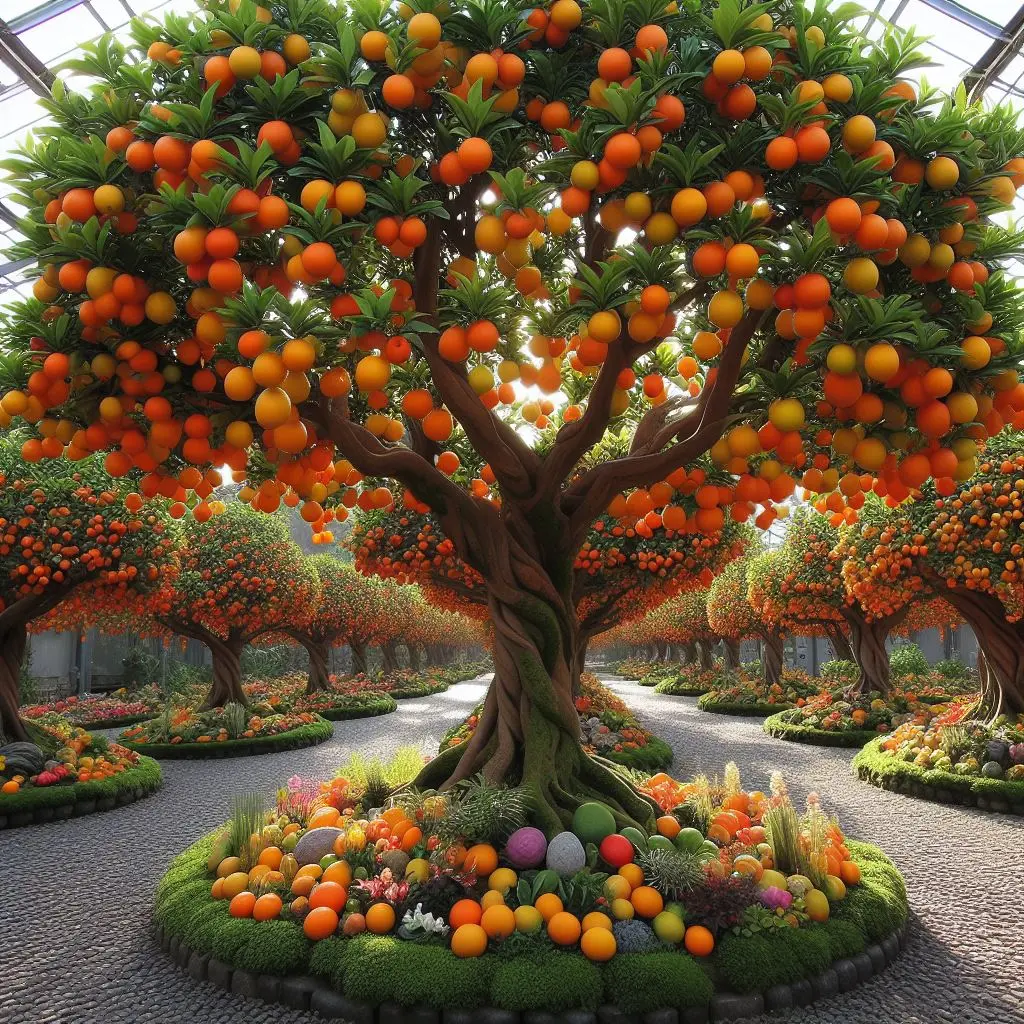
Also known as Kumquat Marumi, it is sometimes referred to as a Pommerac.
The Kumquat tree is among the fruit-bearing ornamental trees that have captivated the attention of many with its beautiful appearance.
The Marumi Kumquat produces orange fruits with green leaves, yielding fruit twice a year. The fruit has a slightly tangy taste, and it can be enjoyed without the need for any additional flavorings.
– **Care Information:**
– **Maintenance Status:** Moderate
– **Watering:** Moderate + Touch the soil to determine watering needs; irrigate when the soil is dry.
– **Light:** Bright + Indirect
– **Soil:** Well-draining + Light soil
– **Plant Height:** In natural and outdoor settings, it can grow up to 2.5 meters, but indoors, it tends to be shorter.
During the winter season, it’s advisable to keep the Kumquat tree away from heating sources. Sprinkling a few drops of water on its leaves in the cold season contributes to the natural well-being of this tree.
| Care Information | Details |
| Maintenance Status | Moderate |
| Watering | Moderate + Touch the soil before watering; if it’s dry, it’s time to water |
| Light | Bright + Indirect |
| Soil | Well-draining + Light soil |
| Plant Height | In natural and outdoor settings, it can grow up to 2.5 meters, but indoors, it tends to be shorter |
**22- Bay Laurel Apartment Plant (Laurus nobilis)**
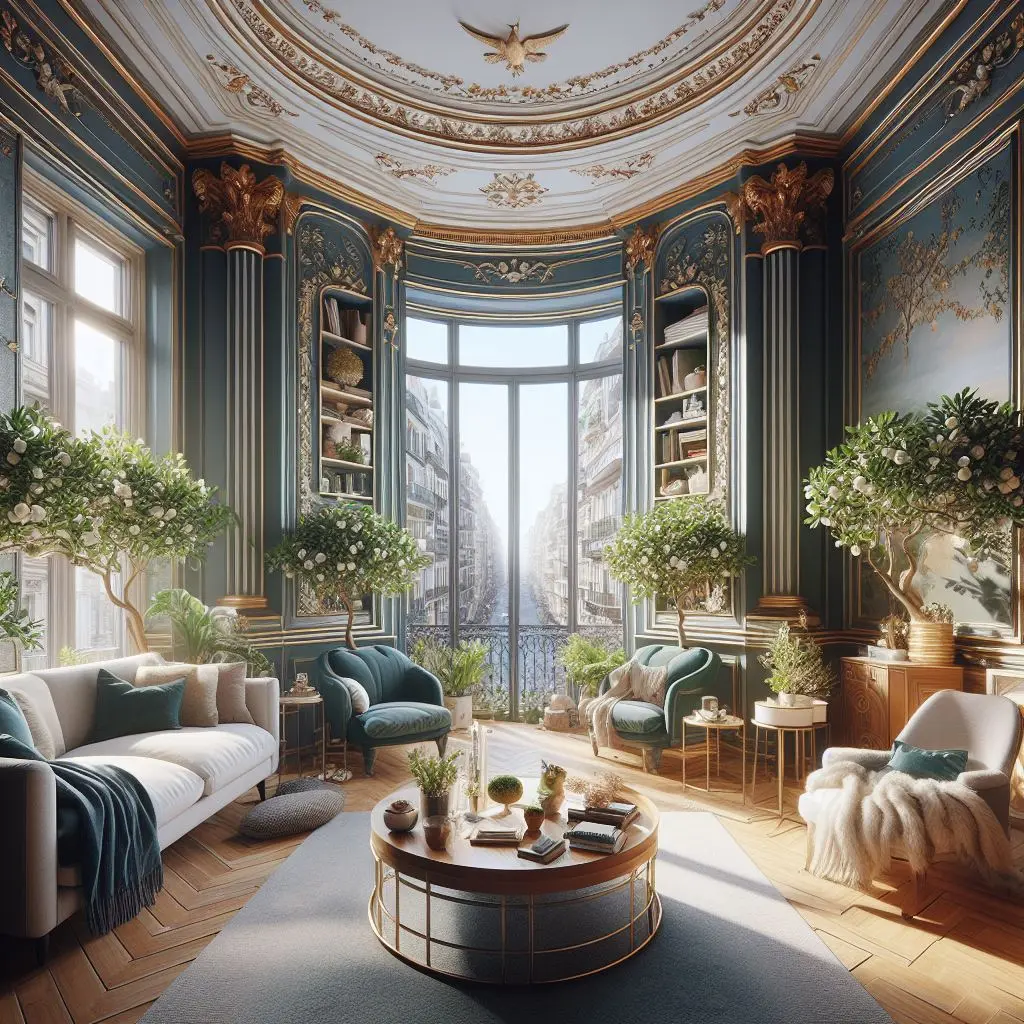
Also known as the Bay Leaf tree, it is sometimes referred to as the Home Bay Tree.
The Bay Laurel is among the perennial evergreen apartment plants that blossom during the late spring to early summer.
The flowers of the Bay Laurel apartment plant emit a delightful fragrance, adding a pleasant and tranquil aroma to the living space. Additionally, the leaves of this plant are edible and find extensive use in the culinary world.
– **Care Information:**
– **Maintenance Status:** Moderate
– **Watering:** Regular and managed + Water whenever the potting soil becomes dry.
– **Light:** Bright + Indirect
– **Soil:** Well-draining
– **Plant Height:** In an outdoor setting, the plant can reach a height between 10 to 20 meters, while in a pot, it typically stays between 1 to 2 meters.
During the winter season, avoid placing the pot of this ornamental flowering tree near heating or cooling appliances.
| Feature | Information |
| Plant Name | Apartment Bay Tree (Laurus nobilis) |
| Other Names | Bay Laurel, Home Bay Tree |
| Maintenance | Moderate |
| Watering | Regular and controlled + Water when the potting soil is dry |
| Light | Bright + Indirect |
| Soil | Well-draining |
| Plant Height | Outdoor: 10 to 20 meters; In Pot: 1 to 2 meters |
| Flowering Season | Mid-spring to early summer |
| Fragrance | Pleasant fragrance from the flowers |
| Edibility | Leaves are edible with various culinary applications |
| Winter Care | Avoid placing near heating and cooling appliances |
23- Guava (Psidium guajava)
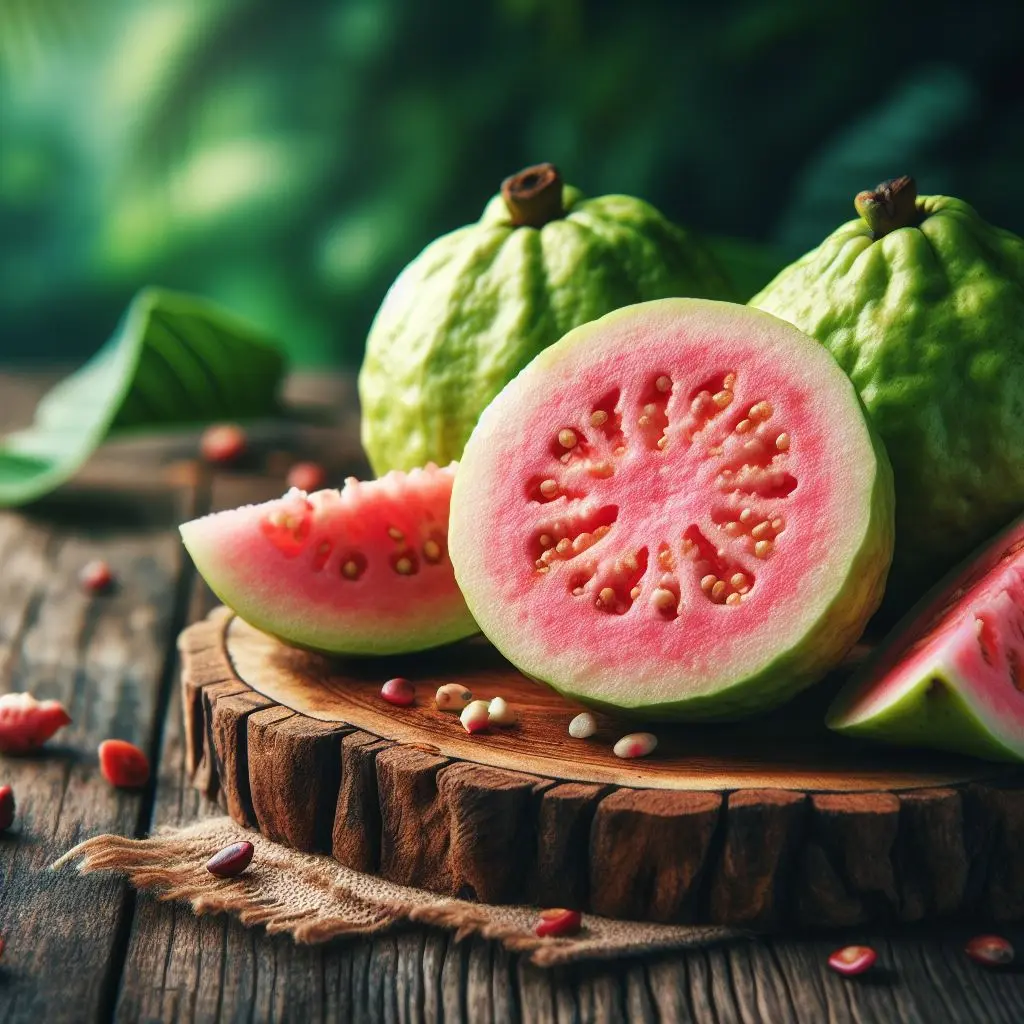
Guava is among the fruit-bearing apartment plants with small, round, and sweet-tasting fruits. This apartment fruit comes in various colors such as green, red, purple, yellow, and more.
- Maintenance Status: Moderate
- Watering: Moderate + Checked regularly
- Light: Bright
- Soil: Well-draining + Loamy and sandy soil
- Plant Height: The height of the plant varies depending on the specific variety, ranging from 5 to 15 meters.
Guava fruit has numerous health benefits, and it can be consumed to meet some of the body’s nutritional needs. Some of the benefits of this fruit include providing vitamins and minerals, abundant fiber, prevention of premature aging, and cancer prevention.
| Feature | Information |
| Plant Name | Guava (Psidium guajava) |
| Maintenance | Moderate |
| Watering | Moderate + Checked regularly |
| Light | Bright |
| Soil | Well-draining + Loamy and sandy soil |
| Plant Height | Varies between 5 to 15 meters depending on the specific variety of guava |
| Fruit Colors | Green, Red, Purple, Yellow, and more |
| Health Benefits | Rich in vitamins and minerals, abundant in fiber, aids in preventing premature aging and cancer, etc. |
24- Azalea (Rhododendron simsii)
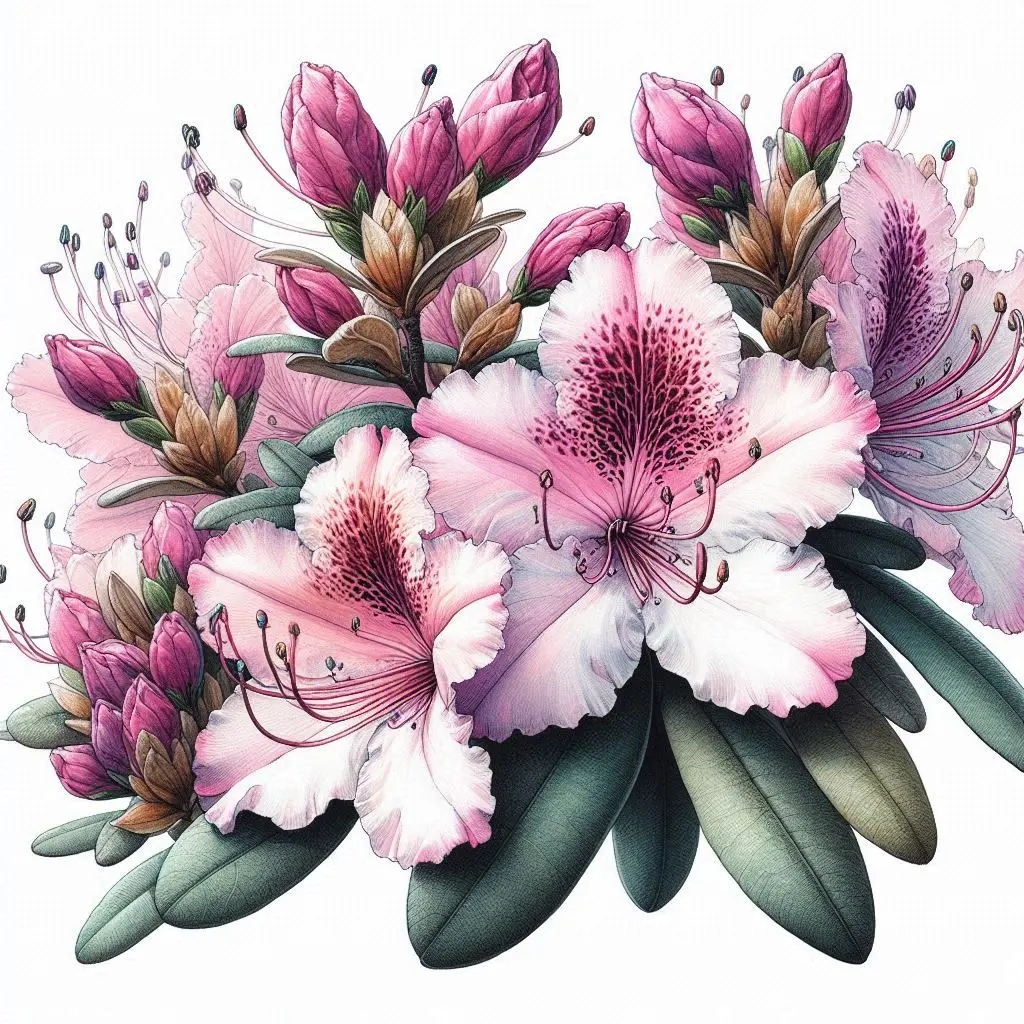
Also known as the resilient Azalea apartment shrub, it is called the Indian azalea.
Apartment flowers from shrubs contribute significantly to the appearance of your home. Azaleas bloom in spring, but keep in mind that the duration of the shrub’s flowers is very short. This species is among the types of ornamental shrubs for green spaces.
- Maintenance Status: Moderate
- Watering: Regular + Check the potting soil before watering; if it’s dry, it’s time to water.
- Light: Bright + Indirect
- Soil: Mixture of dry pine needles + Leaf soil + Sand
- Plant Height: Up to 1.5 meters
If your shrub loses leaves in the fall, don’t worry; this is a natural occurrence. In the autumn season, leaves fall, and in spring, all shed leaves come back.
| Feature | Information |
| Plant Name | Azalea (Rhododendron simsii) |
| Maintenance | Moderate |
| Watering | Regular + Check potting soil; water if dry |
| Light | Bright + Indirect |
| Soil | Mixture of dry pine needles + Leaf soil + Sand |
| Plant Height | Up to 1.5 meters |
| Blooming Season | Spring |
| Leaf Shedding | Natural in fall; leaves will regrow in spring |
25- Sago Palm (Cycas revoluta)
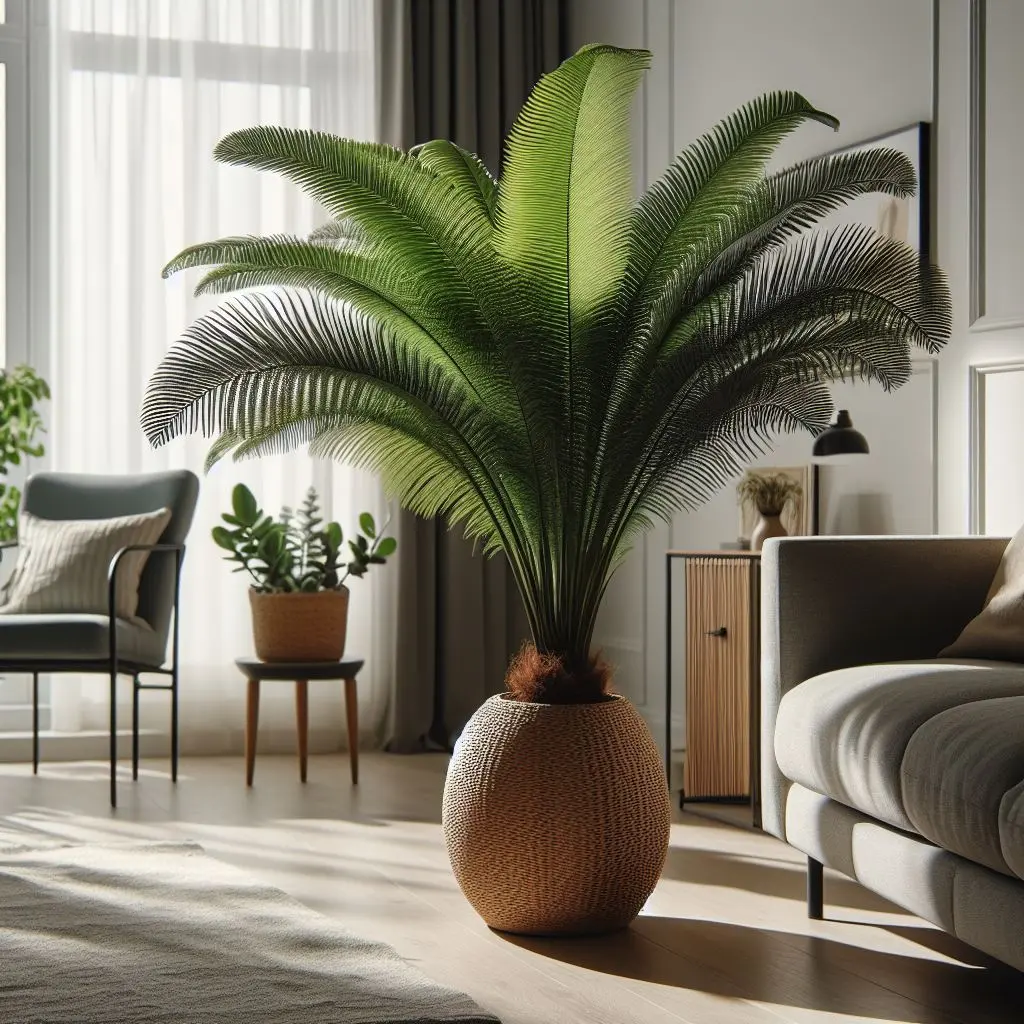
The Sago Palm is a resilient apartment shrub with slow growth. However, this natural floral tree beautifies and enhances the aesthetics of the space with its presence.
In its natural habitat, the Sago Palm can reach significant heights, but in a home environment, it tends to be more compact.
- Maintenance Status: Easy
- Watering: Moderate + Check the soil before watering.
- Light: Moderate + Direct
- Soil: Mixture of sand + Leaf soil + Cactus soil + Clay
- Plant Height: It has good growth with proper care.
Sago Palm requires direct light, but be cautious as excessive light can harm the plant’s leaves, causing them to burn.
| Feature | Information |
| Plant Name | Sago Palm (Cycas revoluta) |
| Maintenance | Easy |
| Watering | Moderate + Check soil before watering |
| Light | Moderate + Direct |
| Soil | Mixture of sand + Leaf soil + Cactus soil + Clay |
| Plant Height | Good growth with proper care |
| Natural Height | Tall in nature, more compact in a home environment |
| Light Sensitivity | Requires direct light, but excessive light can cause leaf burn |
Frequently Asked Questions about Types of Apartment Plants
- What are low-light apartment plants?
– Aglaonema
– Chamaedorea Elegans
– Bonsai Ginseng
– Pachira
– Dragon Tree
– And other plants
- Which apartment plants bear fruit?
– Banana Tree
– Citrus Japonica (Kumquat Marumi)
– Guava
– And other fruit-bearing plants
- **Which plants are considered evergreen apartment plants?**
– Difenbachia
– Begonia
– Ficus Lyrata
– Ficus Benjamin
– And other evergreen plants
- What are some of the most resilient apartment plants?
– Bonsai Ginseng
– Crassula
– Schefflera
– And other resilient plants
- How often does the Kumquat Marumi tree bear fruit?
– This fruit-bearing plant produces fruit twice a year.
- Which apartment plants have broad leaves?
– Ficus Lyrata
– Fig Tree
– Banana Tree
– And other plants with broad leaves
Read SPATHIPHYLLUM by soltech:
The Peace Lily is a popular houseplant known for its beautiful white blooms and dark green foliage. It’s very forgiving and can withstand occasional neglect. The Peace Lily can adapt to lower light conditions, though it does prefer bright, indirect light, such as that from an indoor plant light. It also signals when it needs water by drooping its leaves, making it easy even for beginners to understand its needs!

